Menu
You can manage your membership and billing method by clicking here
Terms of Service
Privacy Policy
Copyright © 2025 Office of Immigration Australia, a private company registered in Australia. All Rights Reserved.

Checking membership status...
 EXCLUSIVE MEMBERS ONLY ACCESS
EXCLUSIVE MEMBERS ONLY ACCESSTo access this month’s edition & Member’s only resources, enter your registered email address.



Exclusive Australian Immigration News, Updates & Opportunities
July 2025
This bulletin is for members only, and provides our members with month to month updates on Australian immigration policy changes and consequential opportunities. Opportunities are found via federal and state government policy shifts for the demand and supply for certain occupations.
This bulletin will keep you up to date so that you do not have to employ expensive immigration lawyers to provide you with monthly research.
July 2025 is here, and once again exciting opportunities and important updates are now reshaping Australia’s immigration landscape!!! Let’s discuss…
In this month’s Federal News: Multi-factor Authentication (MFA) has officially launched on, enhancing cybersecurity for Australia’s migration and visa platform. Users will now authenticate at each login, account creation, and whenever account changes occur.
Meanwhile, net migration in 2024-25 is on track to surpass Treasury forecasts by approximately 45,000, driven by strong immigration flows that have already reached over 360,000 for the first nine months.
We also explore Australia’s broader immigration landscape: since 2000, the population has grown by 40%, the fastest among developed nations. Lastly, we reflect on Australia’s unique position as the country with the 9th largest migrant population globally, despite ranking just 54th in overall population size—a testament to Australia’s continuing role in human freedom and global migration.
In this month’s State News: Skilled workers residing offshore remain eligible to be considered for State and Territory nominations! Please view the State Migration Section of this month’s bulletin for all State and Territory program updates and opportunities available!
In this month’s Economic News: Greater Geelong has taken the crown as Australia’s most popular regional migration spot, surpassing Queensland’s Sunshine Coast, as net migration to regional areas soars 40% above pre-Covid levels.
We also cover insights from a FIFO mining supervisor earning $250,000 annually, who shares practical advice on entering Australia’s lucrative mining industry—highlighting how even newcomers without qualifications can secure high-paying roles.
Plus, we feature an Aussie teen earning $300 per hour with his thriving dog-walking side hustle, proving that impressive incomes are achievable without a university degree!
In this month’s Student News: Australia hit a new record with 1,095,298 international students enrolled by the end of 2024—a remarkable 13% increase from last year! Out of these students, approximately 60% pursue research-level degrees, while around 30% aim for employment opportunities in Australia. In this month’s edition, we explore these employment opportunities including Australia’s top 10 highest-paying jobs that international students can aim for!
All this and much more in the July issue of The Australian Immigration Bulletin! Let’s take a deeper look at what has happened so far and what is planned for the remainder of July 2025 in Australian Immigration, so that you can start planning!
All members now have FREE access to an online IELTS English Platform and course to practice, study and improve their English and IELTS score. The IELTS exam is one of the key recommended exams you will need to take in order to Apply for Skilled Migration to Australia and the better your results, the higher points you will get when submitting an expression of interest. The advanced English and IELTS platform will allow all members to practice Mock IELTS Exams, learn cutting edge tips and gain a greater understanding of how to achieve a Band 7+.
All members also have access to “ImmiConnect” which is now available in the member’s area. ImmiConnect is the Office of Immigration Australia’s Employer Sponsored program which allows overseas workers to receive job interview invitations from Australian employers, when job opportunities come available.
The program aims to bring globally mobile, highly-skilled and specialised individuals to Australia who can fill critical areas of need.
ImmiConnect is exclusive to active Australian Immigration Bulletin Members only. You must be a current Australian Immigration Bulletin Member to be eligible to receive job interview invitations.
So if you are interested in receiving these invitations, please sign up for FREE by Clicking “ImmiConnect” and adding your name and email address.

*2 WINNERS DRAWN EVERY MONTH:
Current Round: June 2025 – October 2025 (10 Winners/Prizes in total)
There is always a winner, and the next one could be you!
The winners of the July 2025 Immigration Prize Giveaway were drawn at 10am AEST on 1st July 2025.

Congratulations to the July 2025 winners! You have been sent a confirmation email with details on how to claim your prize!
The next 2 lucky winners will be drawn at 10am AEST on 1st August 2025.
This Bulletin and its contents is for general information purposes only and should not be used as a substitute for consultation with professional advisors.
As legislation and travel requirements are constantly changing, we strongly recommend obtaining advice on your individual situation from a Registered Migration Agent.
Please click here to book a consultation with one of our Registered Australian Migration Agents, located in Australia.
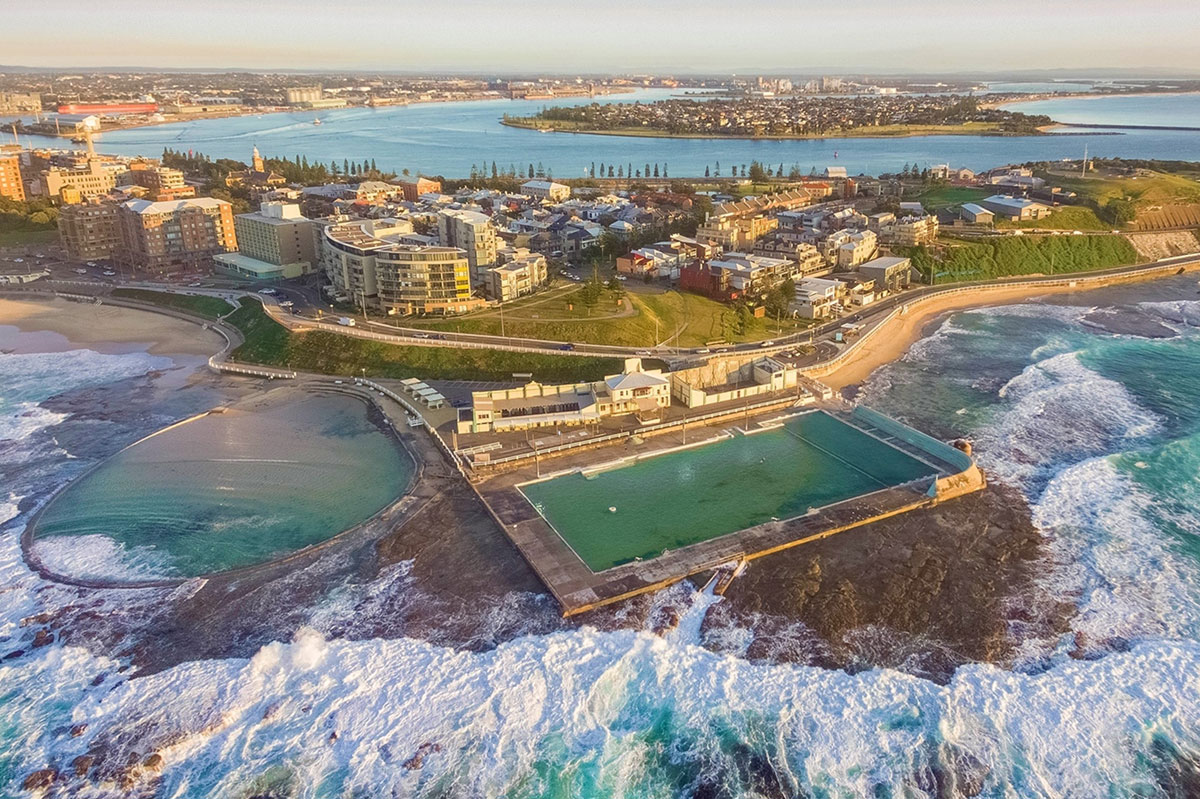
Newcastle, New South Wales
The Results of the August 2021 census were made public on 12th July 2022, and revealed that Australia has become a majority migrant nation, as the census data shows for the first time that more than 50 per cent of residents were born overseas or have an immigrant parent. Last year’s census counted nearly 25.5 million people, including 1 million new residents.
Australia’s 2025 Migration Program has been carefully designed to boost the social and economic outcomes that meet Australia’s needs. In fact, the migration programme was first launched in 1945 following the aftermath of World War 2. Given this long history, it is worth understanding how it works. The Australian Immigration Bulletin exists to help explain this in more detail.
As we’ve entered the 7th month of the year, join us for a look at the latest news and developments in the world of Australian Immigration!
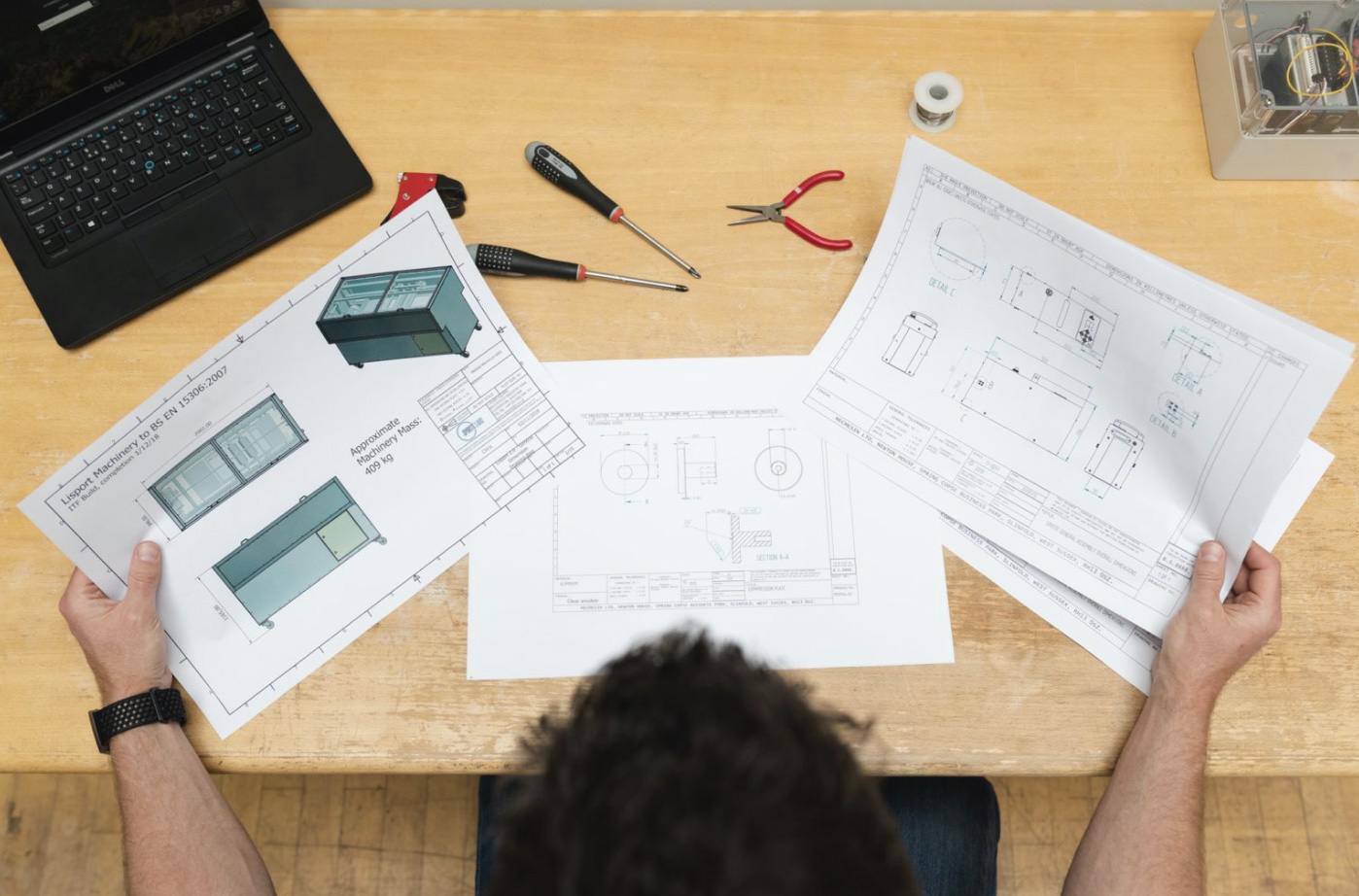
We spoke with Abdullah, a skilled migrant and civil engineer currently working for a private company.
Please tell us about yourself and when you moved to Australia.
My name is Abdullah and I come from Bangladesh and I moved to Australia in 2012.
What are some mistakes some migrants could avoid while looking and applying for jobs?
One acquaintance of mine said that if I found it hard to find a job in my sector, then it’s better to go with customer service or a hospitality job. This is not a bad idea for when you first arrive in Australia. But that is not your limit. The sky is your limit.
My advice to people who are studying, or who are looking for a job is to not limit your ambition.
It is difficult sometimes, because many people do not have the English level to match the requirements, but the language level is not always the main deal-breaker.
What is it that the employers are mainly looking for?
In my opinion, when the employer is looking for someone, they are looking for a sincere person that fits their purpose. They don’t look at whether you are local or international. If you have a good academic background, if you are sincere, if you can prove that you can serve them well, there is no reason for them not to hire you. When you are doing the job search, go beyond your limits.
What other practical advice can you give?
I made a lot of mistakes preparing my resume and cover letter. I didn’t pay much attention to them. During the shortlisting process, the employers don’t see you, they cannot know how smart you are. You probably need to speak to your local friends or those who are already working in the industry. Each industry has different applying procedures. Some industries prefer you to go physically and submit your resume, the others prefer you to apply online.
But the first thing is to pay attention to your resume and cover letter because that’s the first thing the hiring person is going to see. That’s the bridge between your employer and you.

Multi-factor Authentication (MFA) for ImmiAccount is a significant cyber security enhancement that strengthens the integrity of Australia’s primary migration and visa system. MFA protects user information by providing a second layer of security in addition to a password.
ImmiAccount users are now required to authenticate:
ImmiAccount has a step-by-step guide to help you set up MFA. You will need to set up one of the following authentication methods:
The Department does not allow sharing of user credentials under the ImmiAccount Terms and Conditions. You must have your own user credentials.
You can find more information about MFA, including a short video at Multi-factor Authentication (MFA) for ImmiAccount.
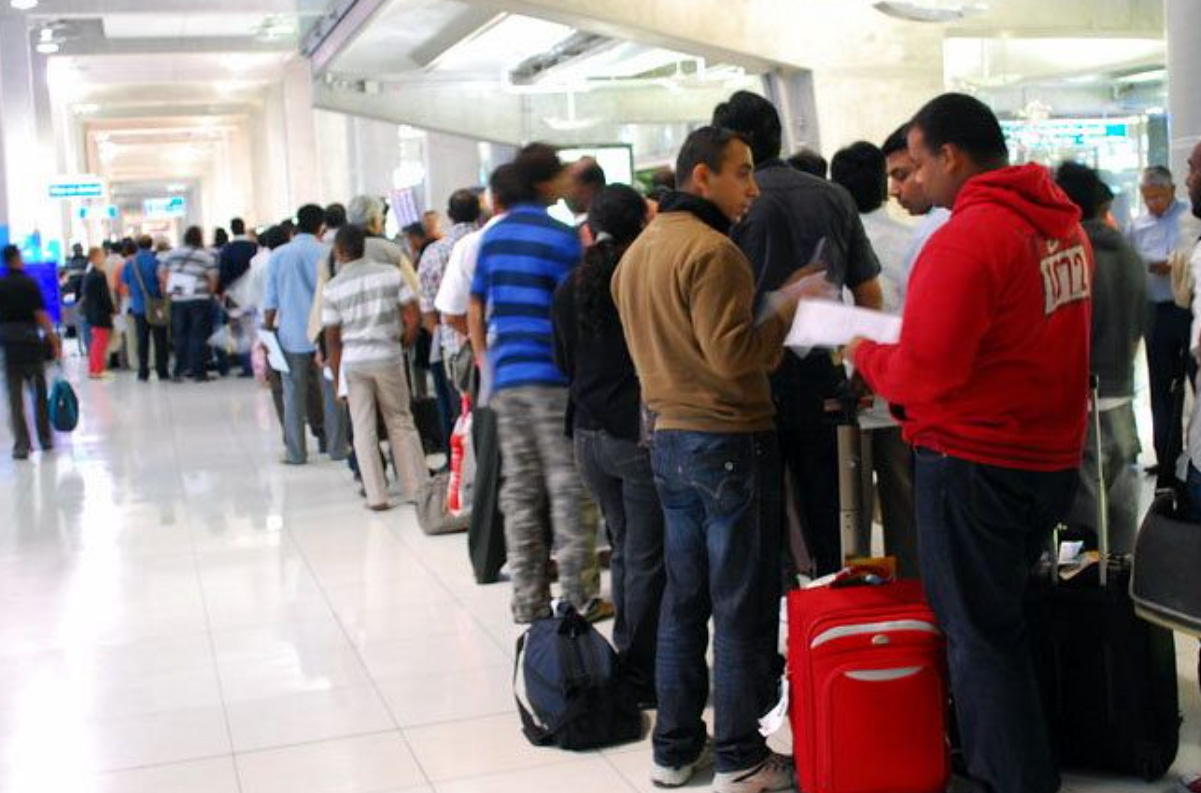
With net permanent and long-term (NPLT) movement for the nine months to March 2025 at over 360,000, the chances of net migration being anywhere near Treasury’s forecast of 335,000 for 2024-25 are now very limited.
NPLT movement is the best early indicator of the level of net migration. In 2023-24, NPLT was 469,140 compared to a net migration outcome of 445,638 (net migration was around 5 per cent less than NPLT).
While COVID disturbed the relationship between NPLT and net migration, that appears to now be returning to normal, with NPLT again slightly higher than net migration on an annual basis (see Chart 1).

NPLT movement for the nine months to March 2025 was 361,670 compared to 397,800 for the same period to March 2024. On a pro rata basis, it needed to fall to under 300,000 for the first nine months of 2024-25 to make the Treasury forecast even remotely plausible.
NPLT arrivals in the nine months to March 2025 were slightly higher than for the same period to March 2024. While NPLT departures were also higher in the nine months to March 2025, this was only marginally so. Departures are not increasing as quickly as Treasury is forecasting.
NPLT movement for the full financial year 2024-25 is likely to be around 400,000, if not more. If net migration in 2024-25 is again 5 per cent less than NPLT, that suggests a net migration outcome in 2024-25 of around 380,000. That would be 45,000 higher than the latest Treasury forecast.
Just for 2024-25, Treasury first forecast net migration for 2024-25 at 260,000. It then increased that forecast in December 2024 to 340,000. For some inexplicable reason, it then reduced the forecast to 335,000 in March 2025.

Australia is in the midst of an unprecedented time in history with immigration continuing to help move the country forward.
The figures are striking.
Between 2000 and 2023, Australia’s population grew by 40 per cent — the fastest rate of any developed nation.
More than 30 per cent of Australia’s population in 2023 was born overseas, for the first time since 1893. (and more than 50 per cent of residents were born overseas or have an immigrant parent).
For every one baby born in Australia now, four migrants arrive. And many of those babies are themselves born to migrants.
The overseas-born population bottomed out at 9.8 per cent in 1947 and has been climbing steadily ever since. 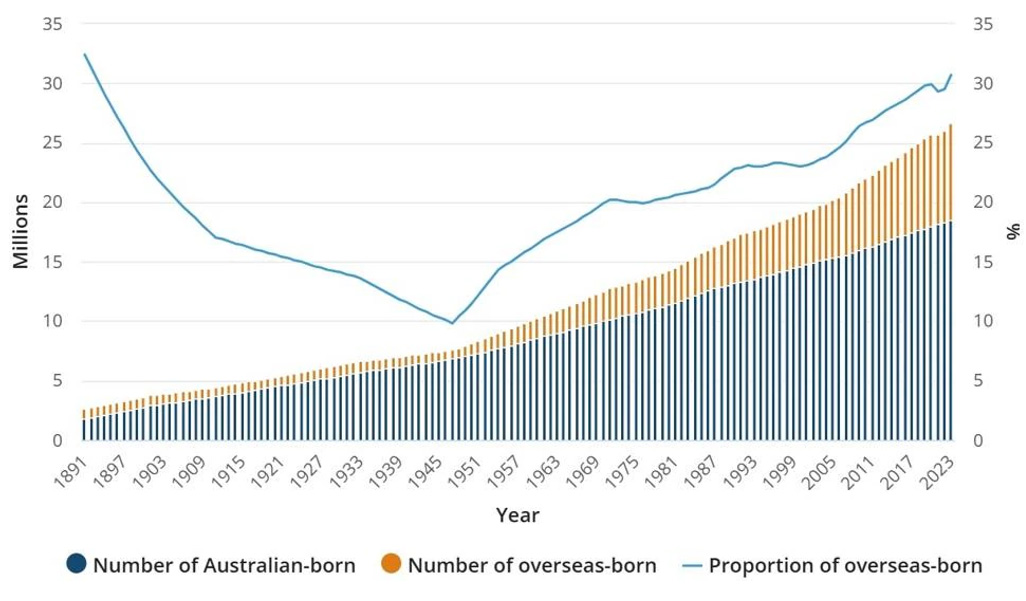
In the 60 years after World War II, net overseas migration — arrivals minus departures — averaged 90,000 per year.
Despite large influxes of migrants from Europe after the war, that figure only reached 150,000 twice in those six decades.
When John Howard kicked off the “Big Australia” boom in the early noughties, net overseas migration more than doubled from its historical average.
Overseas migration – Australia*
After Covid, net overseas migration skyrocketed to an eye-watering record of 536,000 people in 2022-23, dipping slightly to 446,000 in 2023-24.
“We’re not against migration,” said Frank Carbone, Mayor of multicultural Fairfield in Sydney’s west. “Migration is the foundation this country has been built on.”
Today, a new migrant arrives to live in Australia every 44 seconds — that’s nearly 2000 people per day, or more than four full Boeing 747s.
All the while, Australia’s birthrate continues to fall, now at a record low of 1.5 per woman. The birthrate fell below replacement level of 2.1 in 1976 and never recovered.
With zero net overseas migration, Australia’s population would be declining.
Net overseas migration
At the current rate, Australia is adding nearly a Canberra (city) every year.
The federal budget forecasts another 1.8 million people over the next five years — roughly an Adelaide and a Hobart.
In the next 40 years, Australia’s population is officially tipped to grow by 13.5 million — another Sydney, Melbourne and Brisbane — to reach 41.2 million by 2065.
And that number, from the Centre for Population’s 2024 Population Statement, assumes net overseas migration of only 235,000 per year.
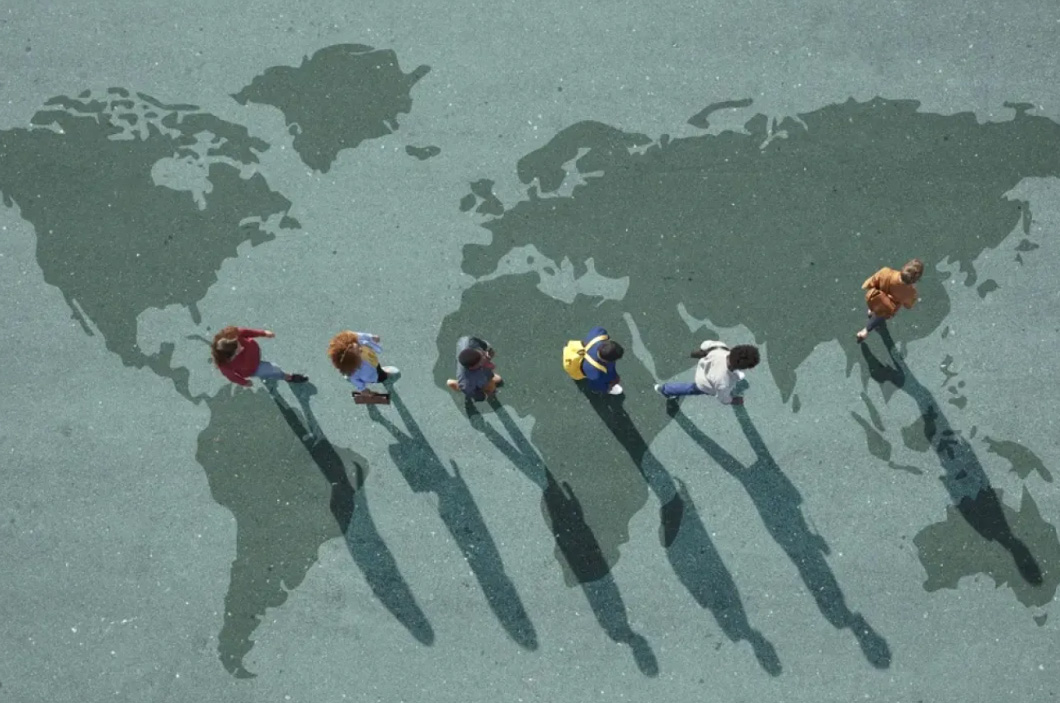
The UN Population Division finally released its 2024 international migrant stock data.
Let’s look at the top-level distribution of migrants around the world and philosophise about freedom.
We start with a simple question about migrants to, and migrants from, Australia.
Australia has the 9th largest migrant cohort of all countries, despite only being the 54th largest country in terms of population.
More than eight million Australian residents were born overseas. This means over 30 per cent of residents in Australia are first generation migrants, and more than 50 per cent of residents were born overseas or have an immigrant parent.
Very few sizeable countries have a similarly high, or higher, share of its population born overseas (dozens of small island nations technically have migrant populations of over 50 per cent).
How many Australian-born people live outside of Australia? The correct answer is 431,000. For every Australian that we send to London, New York or Singapore we compensate by taking in 19 migrants.
The closest opposite of Australia in this respect is Nicaragua which loses 21 locally born people for every migrant it takes in.
Migration-induced population growth tends to be an easier problem to handle than migration-induced population loss. That’s especially the case if you are an island nation with easily to control borders.
This leads us to the question of who the top immigration and emigration nations are.
The most popular migration destination is easy to guess. The US is the global economic superpower par excellence and attracts orders of magnitude more migrants than any other country – over 52 million of its 345 million residents were born abroad.
But would you have guessed the countries with the second and third largest migrant populations? That’s Germany (17 million migrants) and Saudi Arabia (14 million migrants).
Don’t be confused by Russia’s strong migrant cohort (eight million) as this is largely comprised by older people born in former Soviet satellite states who moved to what today is called Russia.
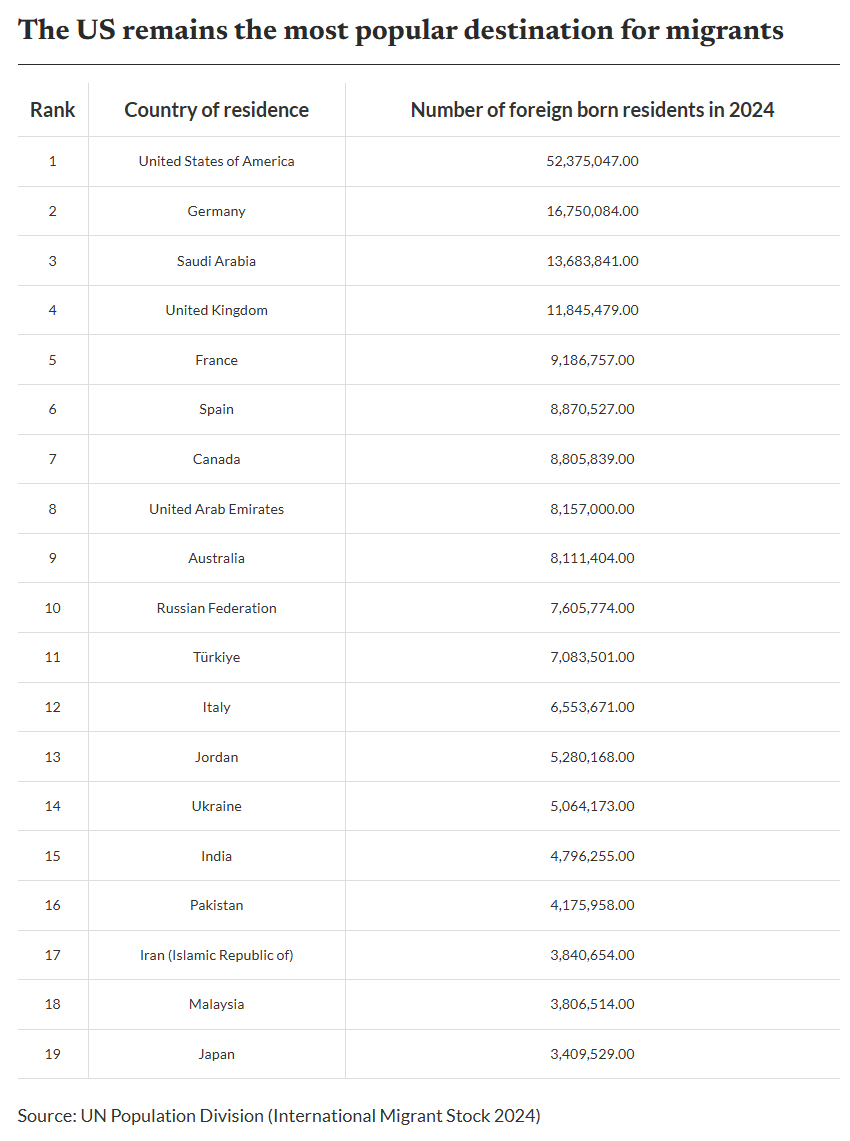
Within the EU three factors drove up migrant stock in recent years – conflicts in Syria, Afghanistan, Iraq, Eritrea and Ukraine led to an increase in asylum seekers.
Open boarders within Europe allowed for a fluent population exchange (and cross marriages) between member countries.
Growing labour market needs in Germany, the UK, Italy, and Spain attracted highly skilled and low-skilled workers from poorer countries.
According to UN data, the world counted 304 million international migrants in 2024 – just 3.7 per cent of the global population.
Put differently, 96.3 per cent of us live in the country they were born in. While the number of migrants has doubled since 1990, the share of the global population that are migrants remained stable.
Despite frequent headlines about refugees and global wars, the vast majority of these migrants moved by choice, not compulsion. Only around 17 per cent (roughly one in six) were forcibly displaced by war, violence or persecution. The rest migrated voluntarily, often seeking better work, education, or family opportunities.
International migration remains a regional affair. About half (45 per cent) of all international migrants stayed within their region of origin.
In Europe and Oceania, more than 70 per cent of migrants moved between neighbouring countries, typically chasing economic or lifestyle improvements.
New Zealanders moving to Australia whenever their unemployment rate is higher than the Australian one is a great example for this interregional migration phenomenon – migrants are mostly pragmatic in their choices.
Even in the poorest regions, like Sub-Saharan Africa, 64 per cent stayed within the region.
Where people did migrate longer distances – such as from Latin America to North America or from Central Asia to Western Asia – most were still driven by opportunity rather than crisis.
Migration, it turns out, remains largely a story of human ambition and freedom, not human tragedy.
Where do migrants come from?
The biggest source country remains India. Over 18 million people born in India have by now moved to a different nation. China and Mexico both saw close to 12 million locally born people move abroad.
The emigrants from these three nations are largely seeking better economic opportunities abroad.
Mexicans moved to the US in search of higher wages, a passport, and remittances. China and India feature relatively highly educated young populations, but also experience high youth unemployment.
Local knowledge economies didn’t emerge as quickly as new university-level graduates were produced. Sending young university-trained workers abroad doesn’t necessarily lead to a local painful brain drain but rather keeps unemployment related problems (costs and social dissatisfaction) down.
War also pushes people out of their country of birth. In Ukraine, Syria, Afghanistan, and even Russia (potential conscripts leaving Russia to avoid being thrown into the Russian war machine) war was the main reason for huge population outflows.
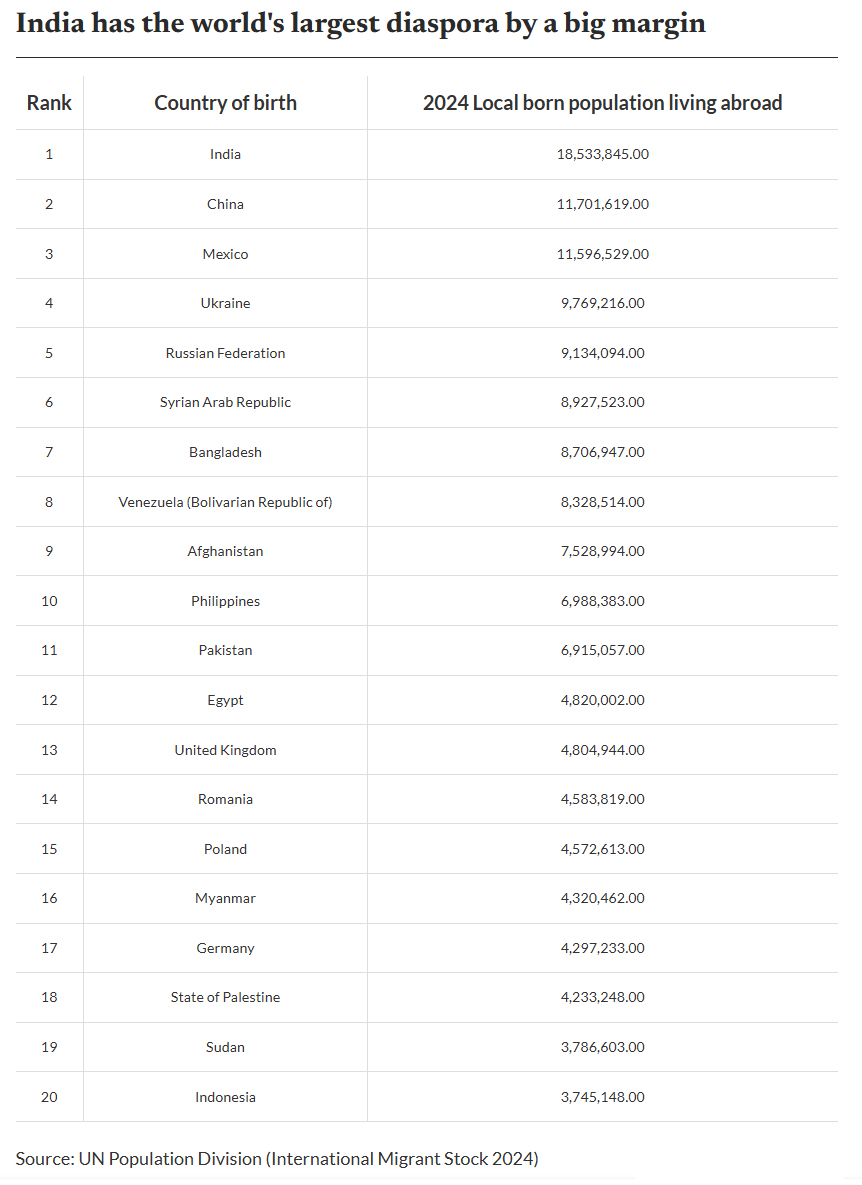
In countries where few people leave and few arrive, mobility isn’t constrained by a happy and satisfied population but by a lack of opportunity, economic barriers, or restrictive policies.
True freedom involves the option to move, not the compulsion to escape, nor the paralysis of being unable to pursue better economic opportunities elsewhere. In that sense, international mobility is not just a demographic statistic it’s a barometer of freedom itself. A lack of international mobility might indicate an unfree nation.
Modern societies can appear outwardly free while constraining people’s choices through fear, disinformation, inequality, and other structural barriers – limitations and options to move freely being one of these barriers.
The sizeable countries that see shockingly low numbers of migrant inflow and outflow are places like Sierra Leone, Rwanda, Ethiopia, Madagascar, or Turkmenistan.
These countries all have large populations and very small numbers (and proportions) of emigrants and immigrants.
Take Ethiopia and its huge population of 132 million people. Less than one per cent of the Ethiopian population was born abroad (1.2 million) and relatively few Ethiopians live outside of the country (1.2 million). International mobility in Ethiopia is the exception, not the norm.
The labelling of migration as a story of human ambition and freedom also suggests that the lack of migration is a story of unfreedom.
The traditional views of the US as The Land of the Free and its status as the predominant destination for global migration go hand in hand.
Likewise, a nation like Australia is grateful for the freedom of mobility that has been granted.

If you are interested in applying for a general skilled migration visa to Australia, it is important to have a good understanding of the skilled visa options and how the migration points test works, so that you can maximise your chances of being eligible to apply for a skilled visa.
A general skilled migration visa is an option available to skilled workers who are seeking to qualify for a skilled visa independently, or under a state or family sponsorship. It is an alternative to an employer sponsored visa.
One of the key criteria to qualify for a general skilled migration visa is the points test (a criterion that does not apply to employer sponsored visas). This is often the most challenging aspect for prospective skilled visa applicants to overcome when seeking an invitation to apply for the relevant skilled visa.
If you are considering applying for a general skilled migration program visa, an important concept to understand is the Expression Of Interest (EOI).
If you are considering applying for a general skilled migration visa, it is important to be aware that for certain visas in this visa class, you will first be required to lodge an EOI with the Department of Home Affairs (the Department) through SkillSelect. The EOI is not a visa application, but rather, it is the process by which you can express your interest in applying for the relevant skilled visa (It’s important to note, that there is NO fee to submit an EOI).
This requirement applies to the following skilled visa subclasses:
Let’s take a brief look at each of these visas below:
The ‘subclass 189’ is a federal sponsored visa that grants automatic permanent residence in Australia. It is subject to nil visa conditions or obligations. For this reason, it is often considered to be the most flexible of the skilled visa options available.
A subclass 189 points-based visa allows you to live and work in any state or territory permanently.
The ‘subclass 190’ is a state/ territory sponsored permanent residence visa. It is another points-based visa for which invitations are issued throughout each month by individual states and territories. One of the benefits of applying for state nomination is that you will be granted an additional 5 points.
An important aspect to consider, which does not apply to the subclass 189 visa is that there is an added step in the application process. In this case, you must also apply for nomination approval to a state or territory government. Only upon receipt of an invitation from the relevant state or territory to which you apply can you then apply to the Department for the visa itself.
Your obligations as a subclass 190 visa holder are that you must commit to your nominating jurisdiction’s obligations and commit to residing in your nominating State or Territory for two years from visa grant.
The ‘subclass 491’ is also a points-based state/ territory (or family) sponsored visa. It is a regional visa with a term of five years. The Department issues invitations for family sponsored EOI applications only (in invitation rounds). Invitations for state sponsorship are issued by individual states and territories throughout each month. This will grant you an additional 15 points for the nomination.
Being a provisional visa, this means it provides a pathway to permanent residence in Australia with the Subclass 191 Permanent Residence (Skilled Regional) visa, subject to meeting specified requirements.
Be mindful that as a subclass 491 visa holder, you must abide by visa condition 8579, which requires you to live, work and study in a designated regional area of Australia. For migration purposes, most locations of Australia outside of major cities (Sydney, Melbourne, Brisbane, Perth, etc.) are classed as regional areas.
If your EOI is successful, you will receive an invitation to apply for the visa, as specified in the invitation letter. This then enables you to proceed with lodgement of your visa application (provided you meet all other visa lodgement and visa grant requirements).
Please note, the below State and Territory program updates is a general overview only. It does not take into account any of your personal circumstances. You must check the State/Territory information carefully to ensure you can meet all the requirements for nomination.
Australia is currently facing a shortage of skilled migrants to fill workforce demands. In response, states and territories have been easing the conditions of their visa programs to help attract skilled workers from overseas.
Below is the monthly update for some of the State and Territory opportunities available.
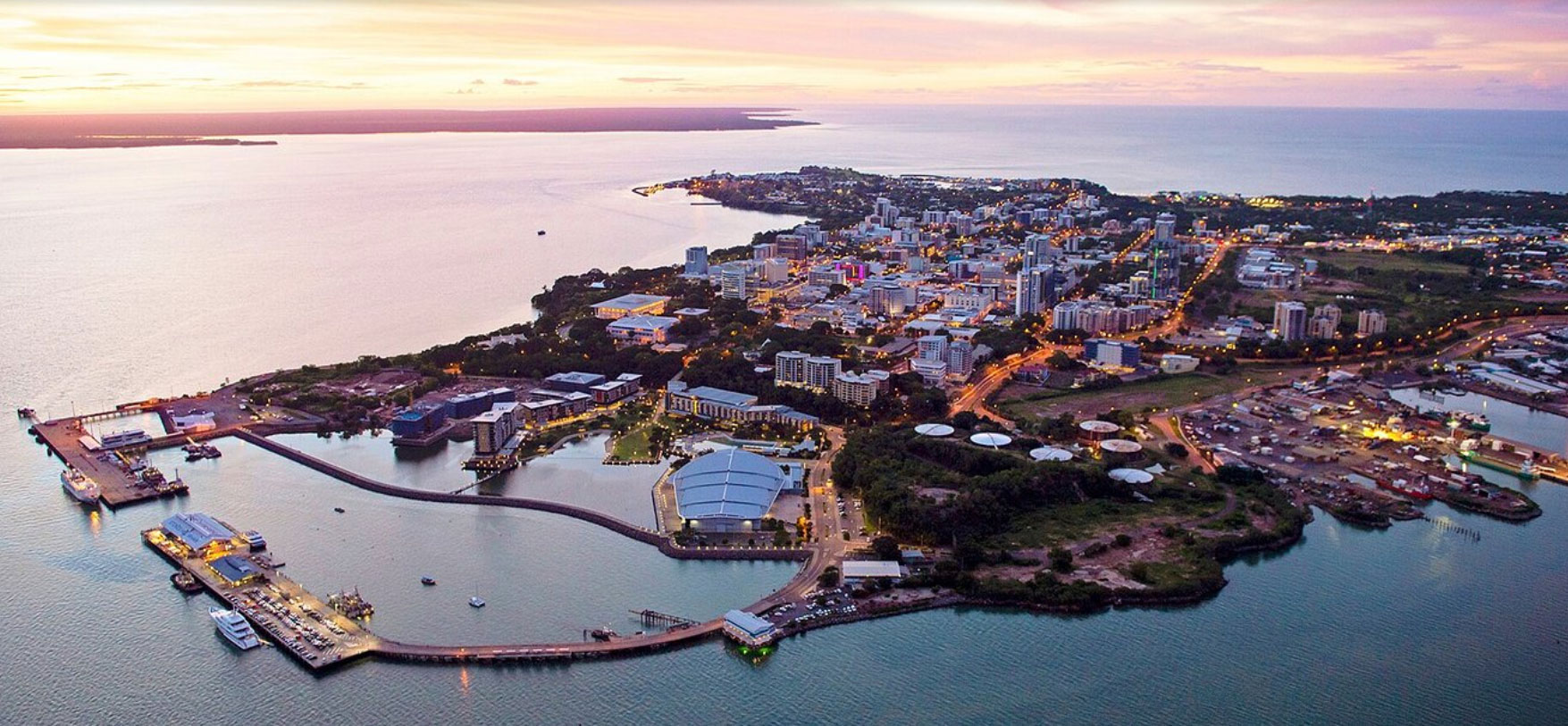
Program Status Update
UPDATE: Northern Territory General Skilled Migration (GSM) nomination applications for 2024-25
Northern Territory has now received sufficient nomination applications to fill the total allocations for the 2024-25 program year. To manage the large number of applications received against the limited allocation of nominations given to the Northern Territory we have suspended our online portal for new applications. All applications received before the suspension will continue to be assessed, and those who meet the eligibility criteria will be issued nominations.
The program will be reopened for new applications once nomination allocations are received for the 2025-26 program year (The program year generally runs from Start of July 2025 – End of June 2026).
During the suspension, applications will continue to be accepted by exception for onshore applicants who have certain visa deadlines before 1 July 2025. For more information on this, please view the update on NT GSM nomination applications for 2024-25 page.
Once the above mentioned temporary suspension is lifted, you may be able to proceed with the NT’s usual skilled migration program. Program details below:
People residing offshore are eligible to be considered for Northern Territory (NT) nomination. Invitations to apply for Northern Territory nomination will be via the ranking system.
The ‘Northern Territory Offshore Migration Occupation List’ identifies the occupations in current demand in the Northern Territory. This List is important if you want to apply for Northern Territory nomination for either a:
The ‘Northern Territory Offshore Migration Occupation List’ is only applicable for those applying for NT nomination from outside Australia, under the Priority Occupation stream.
Please note: The Northern Territory government has advised that offshore applicants will generally only be offered a Northern Territory nomination for a subclass 491 visa. Subclass 190 nominations will only be offered in exceptional circumstances, such as cases where the applicant has strong connections to the NT.
The NT advises eligible applicants to apply as soon as they meet the eligibility criteria. To receive a nomination from the NT Government, you must:
Before submitting an EOI for The Northern Territory, applicants should check that they meet all eligibility requirements.
For a further explanation, see the Frequently Asked Questions page on the Northern Territory Government website.
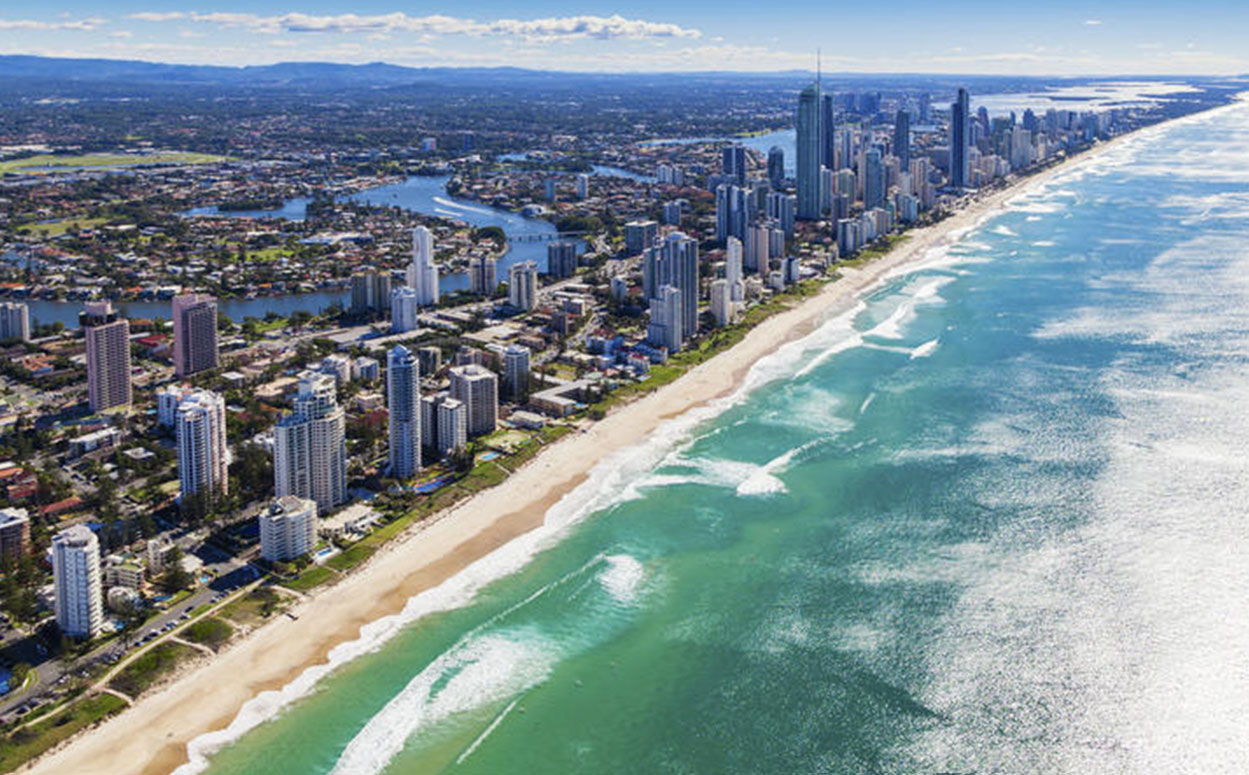
Program Status Update: Important Announcement
Queensland closed its 2024-25 skilled State Nominated Migration Program (SNMP) on May 27 2025.
Migration Queensland will continue to assess the applications currently under assessment until all nominations are completed.
Migration Queensland will resume accepting new ROIs from all eligible candidates when the 2025-26 program commences. (The program year generally runs from Start of July 2025 – End of June 2026).
Migration Queensland will publish details of the 2025-26 program when available.
Once the above mentioned temporary suspension is lifted, you may be able to proceed with Queensland’s usual skilled migration program. Program details below:
Depending on your occupation and situation, there are two state nomination options available for skilled migrants through Queensland.
For Queensland state nomination, prospective applicants must meet the Department of Home Affairs requirements, state-specific occupation requirements and have skills in an occupation that is available on the Queensland Skilled Occupation List.
You may undertake employment once onshore in Queensland through:
Offshore applicants meeting the minimum published requirements are eligible to lodge an Expression of Interest (EOI) on SkillSelect and then a Registration of Interest (ROI) on the Migration Queensland portal.
Migration Queensland has opened the 2024-25 State Nominated Migration Program. For more information, please see here.
NOTE: To be eligible for Queensland’s 2024-25 program, your EOI must be submitted on or after 13 September 2024.
Migration Queensland criteria requires you to:
The 2024-25 Skilled Migration Program is open to both onshore and offshore applicants and provides pathways for skilled workers, graduates, and small business owners.
Before submitting a Registration of Interest (ROI) for Queensland, applicants should check that they meet all eligibility requirements.
Note: In the EOI, select ‘Queensland’ as the only state of interest in the EOI, if you wish to be considered for an invitation to apply for Queensland nomination.
For a further explanation, see the Frequently Asked Questions page on the Queensland Government website.
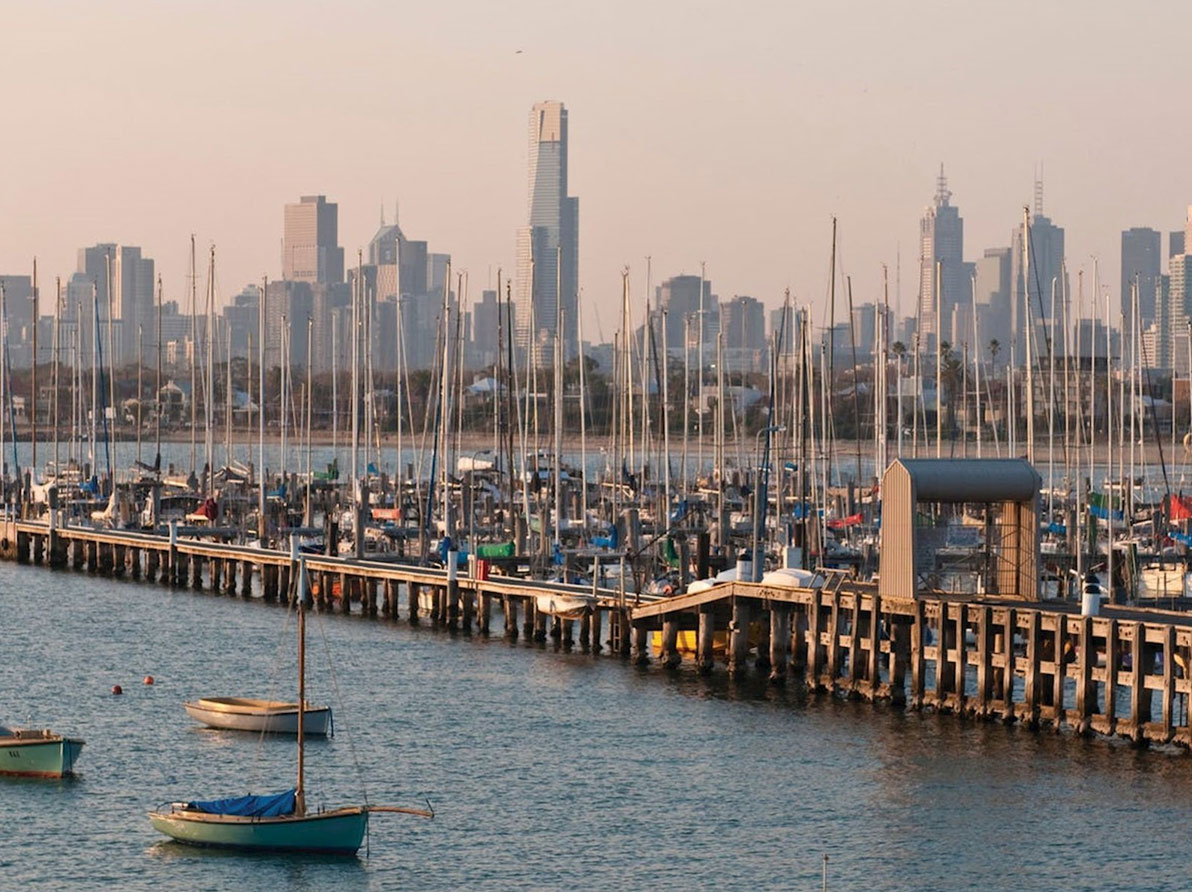
UPDATE: Victoria’s skilled visa nomination program for 2024-25
Victoria’s 2024-25 state nominated skilled visa program has closed to new Registrations of Interest (ROI) as of 4pm AEST on Tuesday 29 April 2025.
The program has attracted a lot of interest this year and has received many more ROIs than available places. Victoria will continue to assess submitted ROIs for any remaining nomination places in the 2024-25 program year.
The program will be reopened for new applications once nomination allocations are received for the 2025-26 program year (The program year generally runs from Start of July 2025 – End of June 2026).
Once the above mentioned temporary suspension is lifted, you may be able to proceed with Victoria’s usual skilled migration program. Program details below:
Open to offshore applicants, the program provides skilled migrants with a pathway to permanent residency in Victoria. The skills that successful applicants bring to Victoria benefits employers and the broader Victorian economy.
The program provides two visa pathways:
As with previous years, applicants will first need to submit a Registration of Interest (ROI) and then be selected on competitive merit to apply for visa nomination.
*Please note: Invitation rounds occur frequently throughout the financial year with no set date.
To be invited to apply for Victorian skilled visa nomination, you must firstly make or update an Expression of Interest (EOI) via the Australian Government’s SkillSelect and then submit a Registration of Interest (ROI).
NOTE: If you previously submitted a ROI and wish to be considered for invitation in the 2024-25 program, you must submit a new ROI.
Both onshore and offshore applicants are eligible to submit a Registration of Interest (ROI) for both the subclass 190 and subclass 491 visas.
Your ROI will remain in the system for selection until it is withdrawn, selected or the program year ends.
Before submitting an ROI for Victoria, applicants should check that they meet all eligibility requirements.
For a further explanation, see the Frequently Asked Questions page on the Victoria Government website.
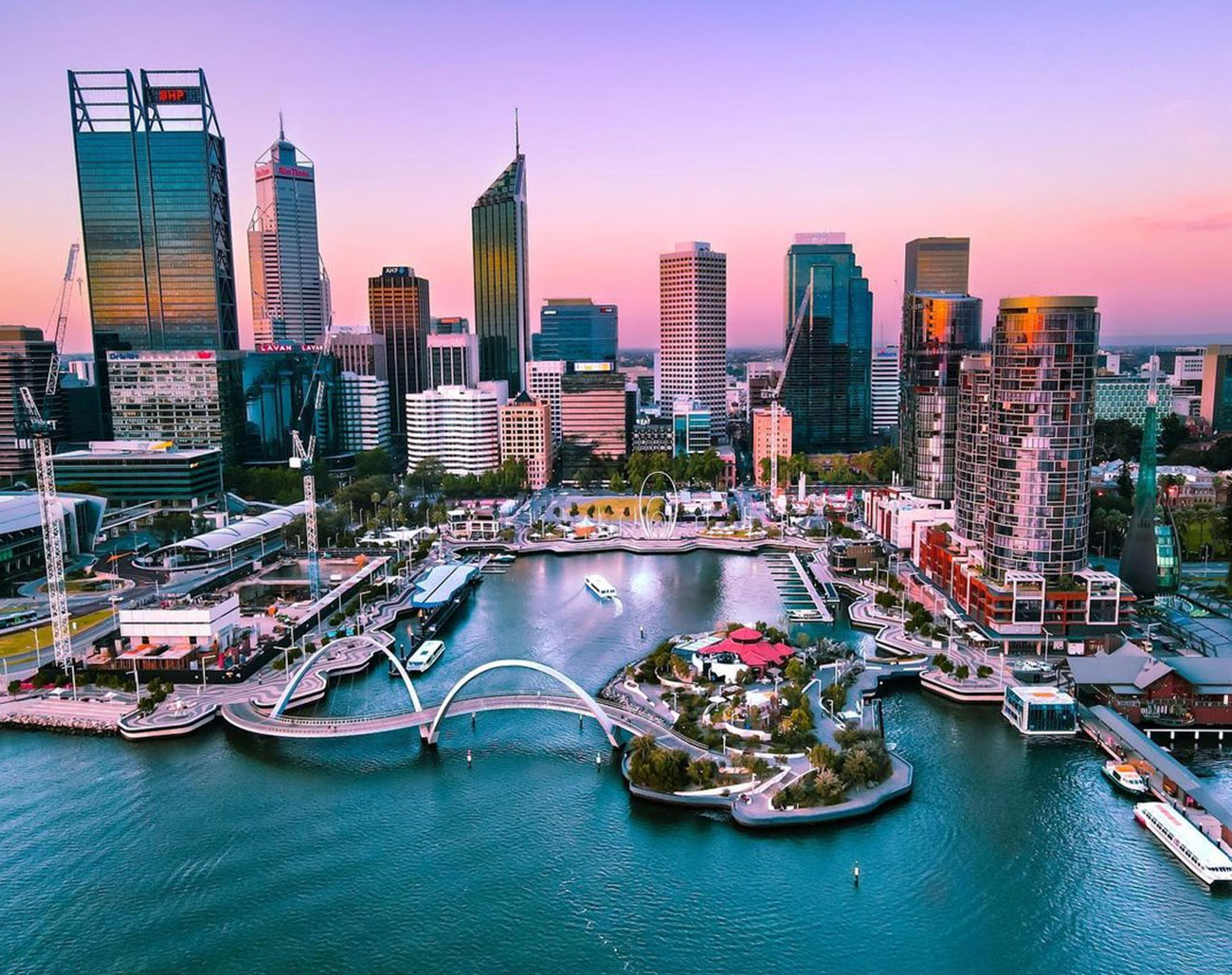
Program Status Update
People residing offshore are eligible to be considered for Western Australia (WA) State nomination. Invitations to apply for WA State nomination will be via the ranking system.
The Western Australian Skilled Migration Occupation List identifies the occupations in current demand in Western Australia. This List is important if you want to apply for Western Australia nomination for either a:
Please note that to be eligible for an invitation in the WA State Nominated Migration Program, you must meet both:
Before starting your application, you will need to check whether your occupation is available on either the WA Skilled migration occupation list (WASMOL) Schedule 1 or 2, or the Graduate occupation list. You can search for your occupation here. (The occupation list search bar is located under the heading ‘Eligible Occupations’.)
Features of the WA 2024-25 State Nominated Migration Program:
Before submitting an EOI for Western Australia, applicants should check that they meet all eligibility requirements.
For a further explanation, see the Frequently Asked Questions page on the Western Australia Government website.
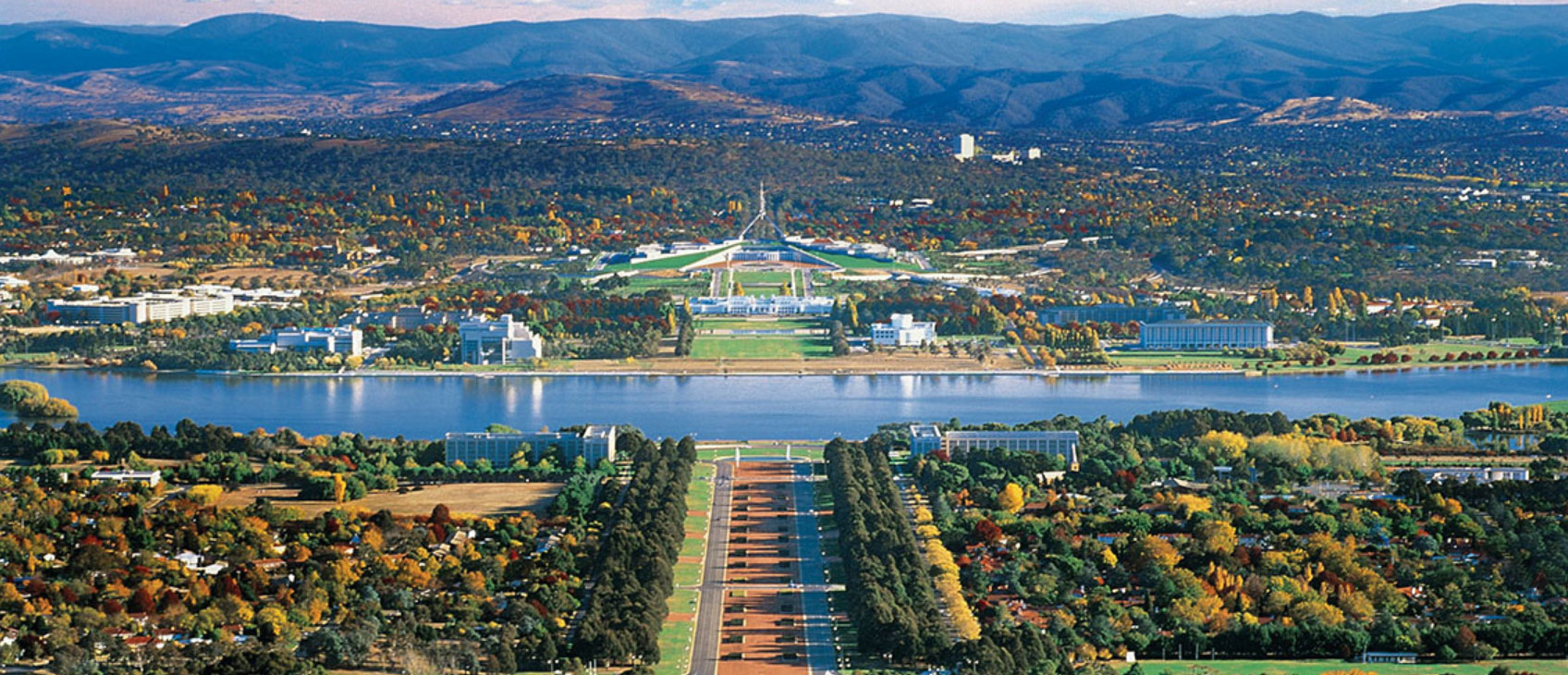
Program Status Update
The ACT Critical Skills List identifies the occupations in current demand in the ACT. This List is important if you want to apply for ACT nomination for either a:
The ACT Government will update this list every four months to make sure that the ACT Skilled Migration Program adapts and responds to the evolving critical skills needs of the ACT economy.
The Canberra Matrix is weighted to ensure that applicants who will make a positive economic contribution to the Territory and/or have demonstrated a genuine commitment to the ACT are more likely to be ranked and invited to apply for ACT nomination.
*ACT nomination does not guarantee a migration outcome. You must still meet the Department of Home Affairs criteria.
Every month, a certain number of nomination invitations are available (prorated on the annual allocation) to those working in the highest ranked Matrix in each occupation.
You can view the ACT’s most in-demand skills for skilled migration by consulting the ACT Critical Skills List.
Before submitting an EOI for The Australian Capital Territory, applicants should check that they meet all eligibility requirements.
Once you’ve submitted a valid Department of Home Affairs Skill Select EOI, follow the ACT Government Process to apply for ACT nomination.
For a further explanation, see the Resources page on the ACT Government website.
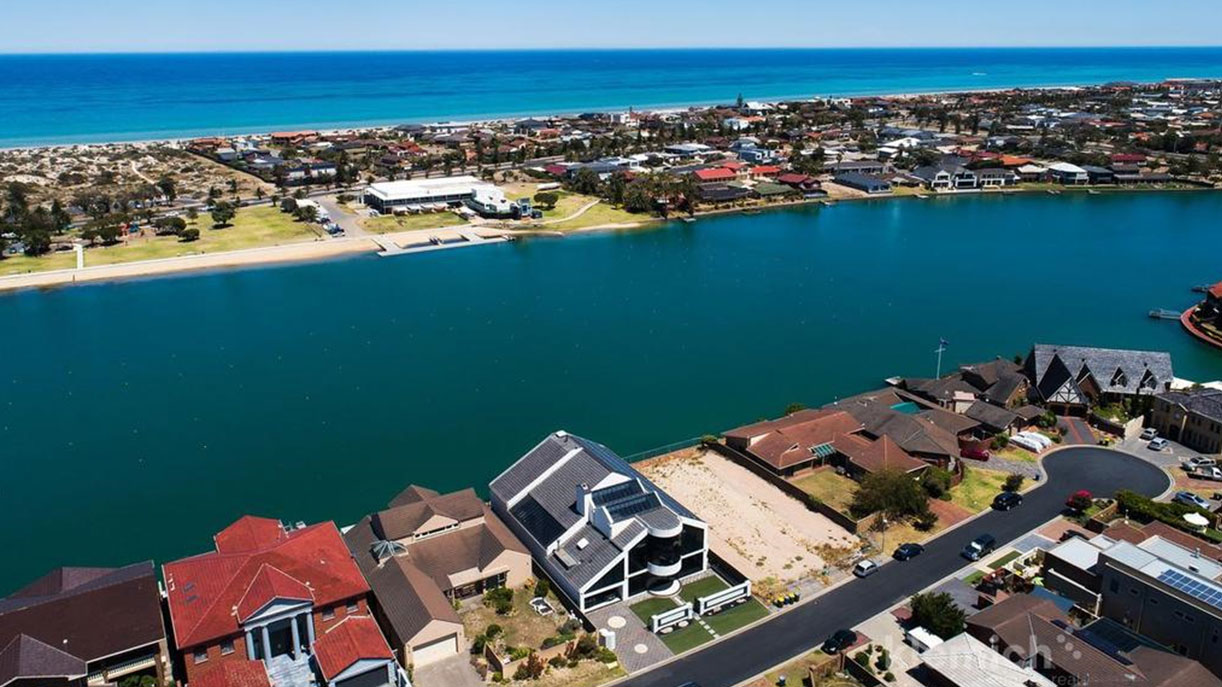
Program Status Update
Depending on your occupation and situation, there are two state nomination options available for skilled migrants through South Australia.
For South Australian state nomination, prospective applicants must meet the Department of Home Affairs requirements, state-specific occupation requirements and have skills in an occupation that is available on the South Australian Skilled Occupation List. Offshore applicants meeting the minimum published requirements can now lodge an Expression of Interest (EOI).
There is an enormous range of occupations on South Australia’s Skilled Migration Occupation List in a range of industries – search for your occupation here.
South Australia will select offshore applicants to apply for state nomination from those who have submitted an Expression of Interest (EOI) through SkillSelect. Offshore applicants will not need to lodge a Registration of Interest (ROI) for this year’s program. South Australia will be nominating offshore applicants from over 250 occupations on South Australia’s Skilled Migration Occupation List.
If you are currently residing offshore and seeking to move to South Australia, the first step is to create an Expression of Interest (EOI) in SkillSelect ensuring you select South Australia as your first preferred State or Territory.
The South Australian Government can then review your EOI for consideration under the Skilled Nominated (Permanent) visa (subclass 190) or Skilled Work Regional (Provisional) visa (Subclass 491).
For most occupations, applicants must have a minimum of three years of skilled employment in their nominated or related occupation within the last 5 years to secure an invitation to apply for SA nomination.
South Australia will be assessing candidates on merit by the following factors:
For occupations in the construction trades (as listed here) applicants must have a minimum of one year of skilled employment in their nominated or related occupation within the last 3 years.
Applicants in the construction trades will be assessed on merit by the following factors:
Before submitting an EOI for South Australia, applicants should check that they meet all eligibility requirements.
For a further explanation, see the Frequently Asked Questions page on the South Australia Government website.
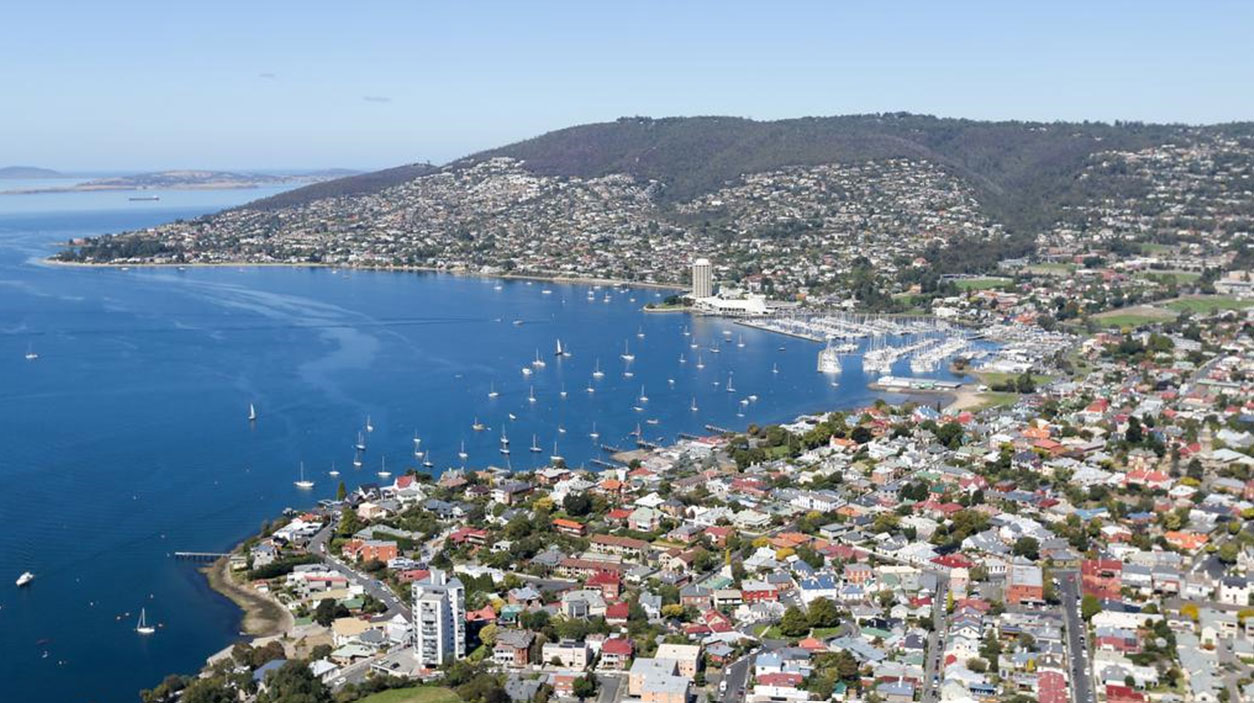
Program Status Update: Important Update – Restrictions on further ROI submission
From 5:00 pm Monday, 19 May 2025, Registrations of Interest (ROIs) will only be accepted from candidates who are allocated a Gold Pass.
From 5:00pm Monday, 16 June 2025, no further ROIs will be accepted for the remainder of the 2024-25 program year.
With demand for nomination now exceeding the remaining places available for the Tasmanian Skilled Migration State Nomination Program, from 5:00 pm Monday, 19 May 2025, Registrations of Interest (ROIs) will only be accepted from candidates who are allocated a Gold Pass.
The Gold Pass category – which applies to candidates who have a skills assessment and eligible employment related to a critical role – will then close at 5:00pm Monday, 16 June 2025, with no further ROIs accepted for the remainder of the 2024-25 program year.
Migration Tasmania will resume accepting ROIs from all eligible candidates when the 2025-26 program commences. (The program year generally runs from Start of July 2025 – End of June 2026).
Further information regarding the 2025-26 program will be published on the Migration Tasmania website and in our newsletter when it becomes available.
Migration Tasmania will continue to assess applications for nomination that have been lodged but not yet decided. However, with few nomination places remaining, not all applicants will be nominated this program year.
Once all nomination places are used, any applications approved will be nominated after Tasmania receives its nomination allocation for the 2025-26 program year.
ROIs that are not invited to apply for nomination before the end of the program will continue to be held in the Application Gateway and considered for an invitation to apply for nomination when the 2025-26 program opens.
Once the above mentioned temporary suspension is lifted, you may be able to proceed with Tasmania’s usual skilled migration program. Program details below:
Working in Tasmania
The two state nomination options available for skilled migrants through Tasmania are:
The Tasmanian State Nomination Skilled Migration Program supports Tasmanian businesses and increases the state’s working age population. It does this by attracting and retaining migrants with skills genuinely in need by employers, or with the capacity to settle in Tasmania through skilled employment in the long-term, and business activities that will increase employment opportunities.
Tasmania’s skilled migration program is for people wanting to move to the state who have skills that Tasmania need. Skilled migrants are attracted to Tasmania because of the state’s enviable lifestyle, career opportunities, affordable housing, reputable schools and a globally recognised university.
The Migration Tasmania Application Gateway is now available for registrations of interest (ROI) and applications for skilled visa nomination from Tasmania.
Anyone seeking Tasmanian nomination for a Subclass 190 Skilled Nominated Visa or Subclass 491 Skilled Work Regional Visa must first register in the Migration Tasmania Application Gateway .
Before submitting an ROI for Tasmania, applicants should check that they meet all eligibility requirements for either;
For a further explanation, see the Frequently Asked Questions page on the Tasmania Government website.
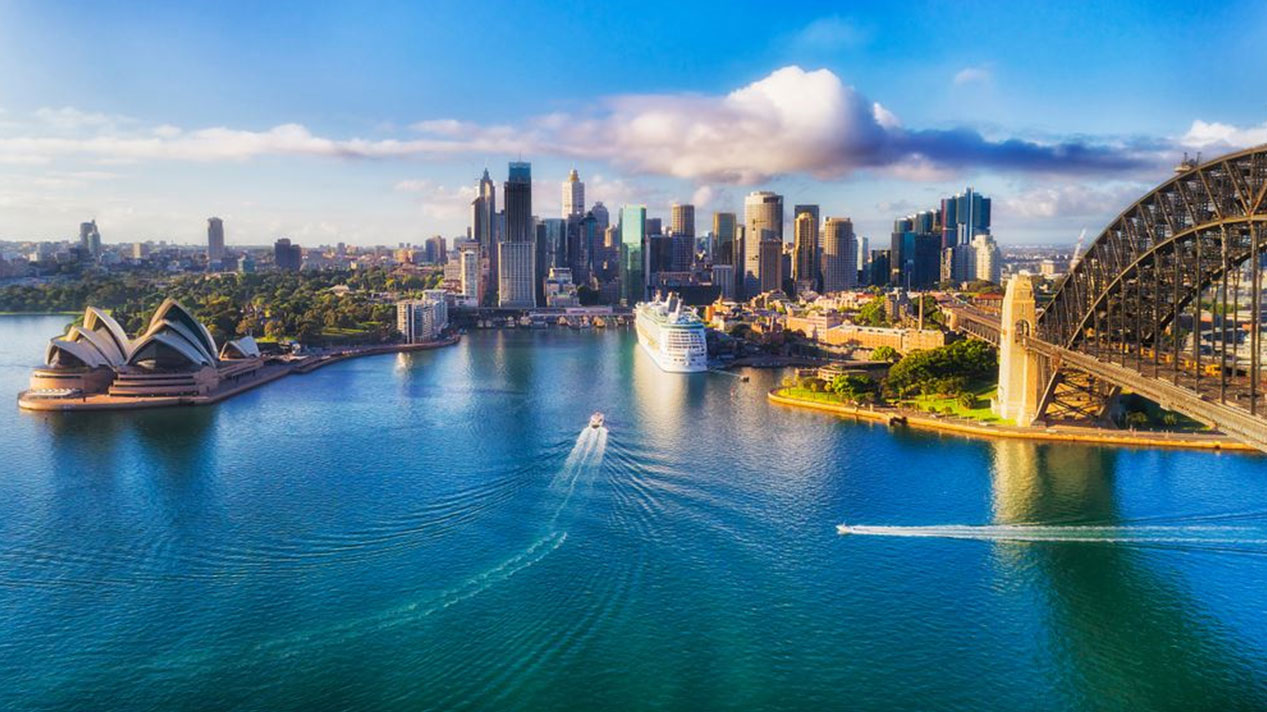
Program Status Update
The New South Wales government has invited applications from offshore migrants under the following nomination streams:
The NSW State Government announced that offshore applicants skilled in certain ANZSCO unit groups are eligible for NSW nomination.
*Please note: Invitation rounds occur frequently throughout the financial year with no set date.
NSW invites and nominates SkillSelect EOIs at the ANZSCO unit group level. To be eligible for NSW nomination (for either Subclass 190 or Subclass 491), your occupation must fall within an ANZSCO unit group identified on the NSW Skills List which reflects skills in high demand across the state, and be eligible for the visa.
Before submitting an EOI for New South Wales, applicants should check that they meet all eligibility requirements for either;
For a further explanation of how the skills list works, see the Common questions about skilled visas page on the NSW Government website.

Geelong takes first place among Australian movers, as net migration to regional Australia climbs 40 per cent above pre-Covid levels.
Victoria’s Greater Geelong has toppled a two-year winning streak by overtaking Queensland’s Sunshine Coast to become the country’s most popular destination among Australian movers, after securing regional Australia’s biggest share of net internal migration.
The latest Regional Movers Index (RMI) report shows in the 12 months to March, the Greater Geelong local government (LGA) had a 9.3 per cent share of total net internal migration, compared with the Sunshine Coast’s 8.9 per cent.
The southern change comes amid an uptick of movement out of metropolitan areas to the regions, with capital city to regional relocations increasing by almost 11 per cent on last quarter to sit 20.5 per cent above the pre-COVID average.
The RMI is a partnership between the Regional Australia Institute (RAI) and the Commonwealth Bank of Australia (CBA), which analyses quarterly and annual trends in people moving to and from Australia’s regional areas.
RAI CEO Liz Ritchie said the data in this quarter’s report demonstrates shifting migration patterns within Australia.
“The nation’s love affair with regional life is showing no signs of abating with 25 per cent more people moving from capital cities to the regions, than back in the opposite direction. Further, net migration to regional Australia is now sitting 40 per cent higher than the prevailing level in the pre-pandemic era,” Ms Ritchie said.
“Regional Australia is being reimagined. The regions’ enviable lifestyle offerings, buoyant jobs market, position as an economic leader and diverse communities are proving to be an ongoing lure, particularly for those in metropolitan areas. Contemporary regional Australia has what people are looking for and it’s clear clichéd images and misconceptions about regional living are well and truly a thing of the past.”
Greater Geelong’s ascent on the leaderboard was set against a background of a rise in popularity in regional Victoria as a whole. The state captured 34 per cent of the total net inflows into all of regional Australia during the March 2025 quarter, larger than the 28 per cent share in the March 2024 quarter.
In addition, the two LGAs that recorded the highest annual growth in total net internal migration inflows were also in Victoria: Latrobe and Murrindindi.
CBA Acting Executive General Manager Regional and Agribusiness Banking Josh Foster said it demonstrates the vitality of Victoria.
“It’s pleasing to see annual population growth is continuing to benefit Australia’s regional economy as more people are drawn to the lifestyle and employment opportunities found beyond metropolitan areas. In a first for the RMI, Greater Geelong has become the star performer due to its idyllic location, established services and range of employment opportunities. This is underpinned by significant government and corporate investment in the region, including the Geelong Convention Centre which is due to be completed in 2026, and the Barwon’s Women and Children’s Hospital renovation and expansion expected to be completed in 2026/2027,” said Mr Foster.
Geelong’s close proximity to Melbourne’s CBD, airports, ports and freeways eases accessibility to and from the region and offers businesses an enticing proposition enabling them to relocate or scale their operations, while benefiting from the area’s growing skilled workforce and steady dynamic economy.”
One business looking to capitalise on the opportunities Geelong presents is Gouge Linen and Garment Services, a leading linen and garment cleaning service in Australia. It has expanded from a regional service headquartered in Shepparton to a statewide operation, securing major contracts and expanding its facilities, including the opening of distribution centres in Ballarat, Melbourne and Bendigo.
“The business now employs 480 staff to service seven locations across Victoria, and is working towards further expansion,” said Rob Priestly, Gouge Linen’s co-owner and Director. “Lots of thought and planning has gone into our new plant in Geelong and we are finally executing on those plans with help from CBA. There are lots of exciting growth opportunities for us from the platform of a second major plant and the start of early production is imminent.”
The company has a history of providing opportunities to migrants and refugees looking to enter the workforce and hopes to continue this initiative when the new plant opens. “The business sees the benefit and the value of the workforce, and the business support you get from being located in a regional economy that allows us to grow and service a metropolitan market as well,” added Mr Priestly.
Sydney continued to record the largest net outflows of all capitals (64 per cent), with regional New South Wales securing the biggest share of regional area net inflows at 40 per cent. Regional Queensland’s share of net inflows fell to 17 per cent, down from 30 per cent in the March quarter of 2024; whereas regional Tasmania’s net inflows went from a –3 per cent share a year ago to 3 per cent in the first quarter of the year.
While the Sunshine Coast and regional Queensland’s share of movers dropped this quarter, the state remains popular with those relocating regionally with destinations such as the Gold Coast, Townsville, Gladstone, Gympie and Fraser Coast all making various hot spot lists.
“Queensland’s warmer climate and generally more affordable housing in regional locations ensures that it remains a magnet for movers from Sydney and Melbourne,” said Mr Foster.
“The growth in migration to the state is also due to significant investments in large industrial infrastructure projects related to resources and renewables like the CopperString 2032 project set for completion in 2029. This initially involves building 840km of new electricity transmission line from Mount Isa to near Townsville, generating employment and economic opportunities throughout North Queensland, and will connect Queensland’s North West Minerals Province to the National Electricity Market for the first time in Australia’s history.
“For over 110 years, CBA has played an active role in contributing to the livelihoods of our country’s thriving regions and we continue to support the everyday banking needs of local communities and businesses. By partnering with customers to unlock funding for future projects we aim to create sustained growth,” added Mr Foster.
Movement was not restricted to the eastern seaboard however, with Victor Harbour in South Australia recording strong interest from regional movers, and Denmark and Harvey in Western Australia remaining popular with both regional and city movers alike.
“Regional Australia’s population is now sitting at 9.91 million people, and this data indicates that number will continue to grow,” Ms Ritchie said.
“It’s imperative that regional Australia is on the radar of decision-makers at all levels. There are big economic gains to be made by supporting, facilitating and nurturing growth across the regions. Those benefits can only be achieved though, by ensuring communities have the infrastructure, facilities, funding and support they need to continue to welcome all those who are actively choosing a regional life.”
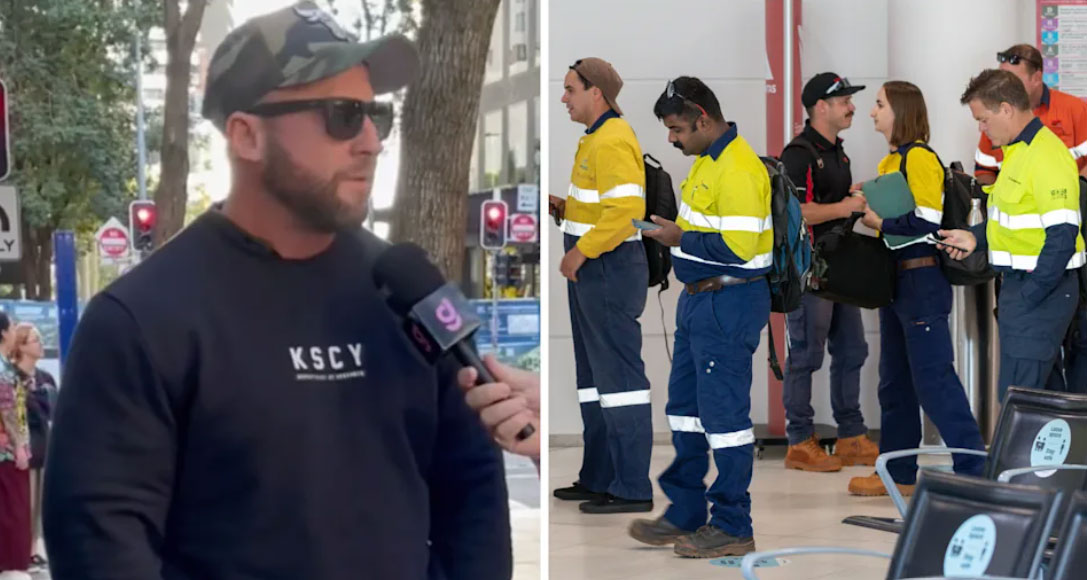
The Brisbane man was stopped in the street and shared he had been working in the mines for the past 16 years. The Brisbane man shared he was earning $250,000 working as a FIFO supervisor in the mines.
An Australian FIFO supervisor has shared his best advice for other people hoping to get into the mining industry. Many people are attracted to working in the industry due to the high salaries on offer and the lifestyle flexibility, and you don’t necessarily need to have qualifications to get in.
The man revealed he was earning a $250,000 salary package as a fly in, fly out [FIFO] supervisor in the mines. He said he had been working in the mines for roughly 16 years after starting his career as a truck driver and working his way up.
“FIFO, so you miss a lot of things, but you also gain a lot of things, you only work half the year. 7 on 7 off is my roster,” he said.
He said there were ways people could get into the mines without having any experience under their belt.
“Either go through the labour-hire companies, so they’ll train green, we call them green like unskilled people. Or you apply for traineeships [at] the actual companies like BHP or Rio [Tinto] or Glencore,” he said.
The man said there were a ton of perks to working in FIFO, including the working hours.
“To come down here and earn what I’m on now, I’d have to work in a high management role and work twice as hard for less money,” he said.
On top of that, he noted that expenses like food, accommodation, the gym and buses were all provided for workers.
According to SEEK, the average annual salary for miner jobs in Australia ranges from $125,000 to $145,000.
What types of entry-level FIFO jobs are available?
There are a range of different entry-level FIFO jobs on offer.
FIFO recruiter Alana said drillers offsiders and bus drivers were two popular entry-level jobs.
Drillers offsiders can earn between $120,000 and $150,000, but Alana warned it was a “hard” job that required a “very intense level of physical fitness”.
Bus drivers can earn $110,000 a year, she said, and while it is classified as an entry-level job, you will need a bit of experience and a relevant licence and authorisation.
If working on the tools as a tradie or a labourer isn’t for you, there are also a bunch of FIFO administrative, hospitality and utility jobs available.
These are the people who work behind the scenes to ensure FIFO villages are functioning, miners are fed, and beds are ready. You may be able to work as a cleaner, chef, bartender, driver, kitchen hand, or barista with little to no experience required.
Bartenders, for example, can typically earn between $80,000 and $90,000 per year in the role.
A number of FIFO workers have said it can help if you know someone already in the industry.
If you don’t know any existing connections, workers have advised people to keep a close eye on jobs advertised and to apply, apply, apply.
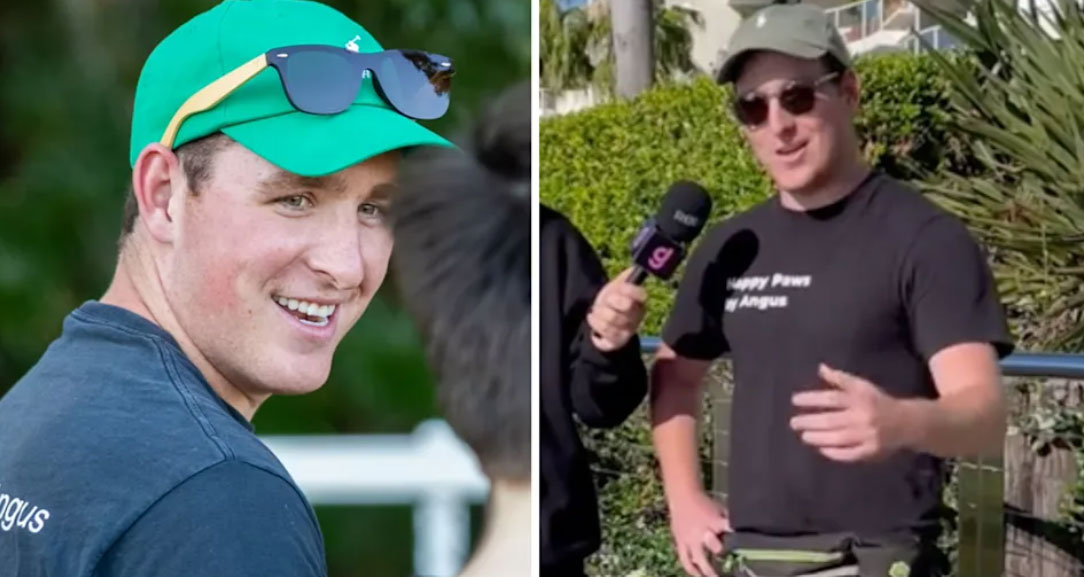
Angus started his side hustle while he was in high school and he’s able to pull in thousands of dollars per week. Angus has been operating his dog walking business for several years and he’s able to pull in a decent chunk of money.
An Australian university student has revealed the side hustle job that pays him sometimes as much as $300 per hour. Angus wasn’t allowed to get a dog when he was young, so he decided to walk other people’s pets in his spare time.
What started as a small-time gig while he was in high school has now morphed into a five-day-a-week job. He revealed he gets paid $50 per dog for an hour-long walk.
“I do three packs a day. Keeps me busy, which is good. I mean, walking along here [in Brisbane] each day, can’t complain,” he said.
When the 19-year-old was stopped on the streets of the Queensland capital, he was walking four dogs, meaning that hour alone saw him earn $200.
He said his biggest pack was six dogs at once, which would have been a $300 gig.
His pack size could change across the day and across the week, so it’s hard to work out how much he could make.
But if he only walked one dog per session, he’d pull in $750 per week, $3,000 per month, or $36,000 per year.
If he were able to do his biggest pack size three times a day, every day, he’d make $4,500 per week, $18,000 per month, or a jaw-dropping $216,000 per year.
Healy said he works the job into his weekly university schedule, and it’s helped him keep on top of everyday bills and expenses. He hopes it will eventually allow him to buy a house.
“I love it, it’s good,” he said. “But, I mean, it’s like any business, [where] you have expenses and stuff.”
He said sometimes he’ll be able to do a walk with multiple dogs if they’re social and relaxed, however, he also did one-on-one walks with pooches that might not gel well with others.
You don’t technically need any qualifications to be a dog walker in Australia.
Aspiring dog walkers can take certain online courses to brush up on their knowledge of certain breeds or dog behaviour.
People starting out in the industry can expect to charge around $20 to 25 per hour, however, that can reach up to $30 to 50 per hour once they have a bit more experience.
There’s a lot of money in the dog world
A woman who owned a dog behavioural business revealed she charged $80 per dog to look after them for several hours.
This involved a 5km walk in the morning, as well as some off-lead social play time, followed by a nap and more social interaction in the afternoon.
She also does one-on-one sessions with owners to help them improve their dog’s behaviour and temperament.
While each day can vary, she said her team looked after between 12 to 22 dogs per day.
That means her business was pulling in up to $1,760 every single day.
Being a dog behaviouralist takes a bit more training than being a dog walker.
Dogs Australia said the industry isn’t properly regulated, meaning people could call themselves a dog behaviouralist without proper training.
But you can help legitimise yourself by completing a course like the Certificate IV in Companion Animal Services – Knowledge assessed and Skills Assesses, or the Certificate III Canine Training & Behaviour-Knowledge Assessed and skills assessed.
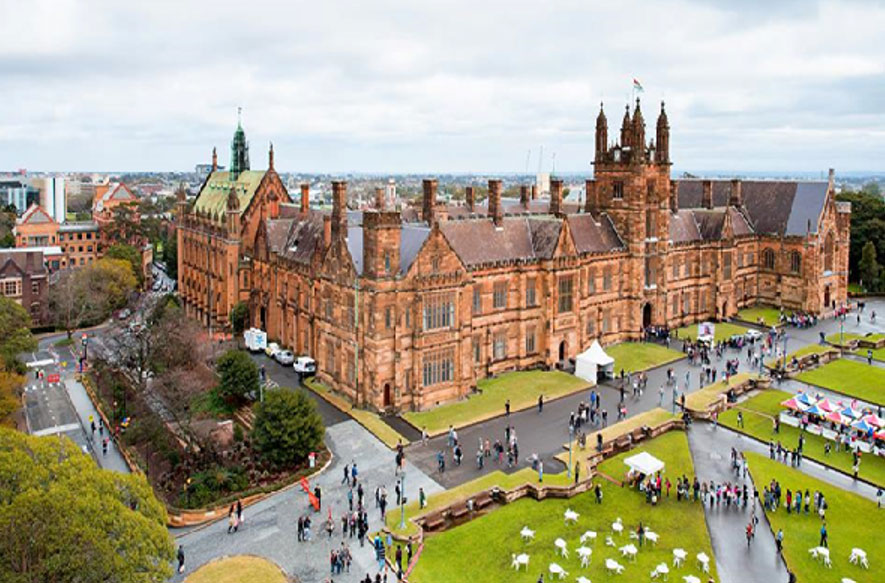
The latest data from the Department of Education shows that there were a record 1,095,298 international students enrolled in Australia at the end of 2024, an annual increase of 13%.
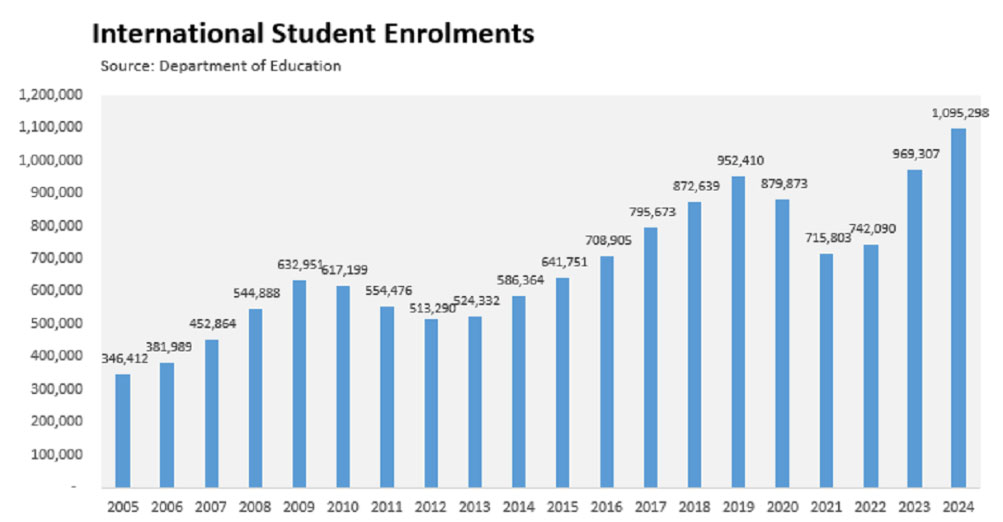
There were also a record 571,986 new enrolments at the end of 2024.
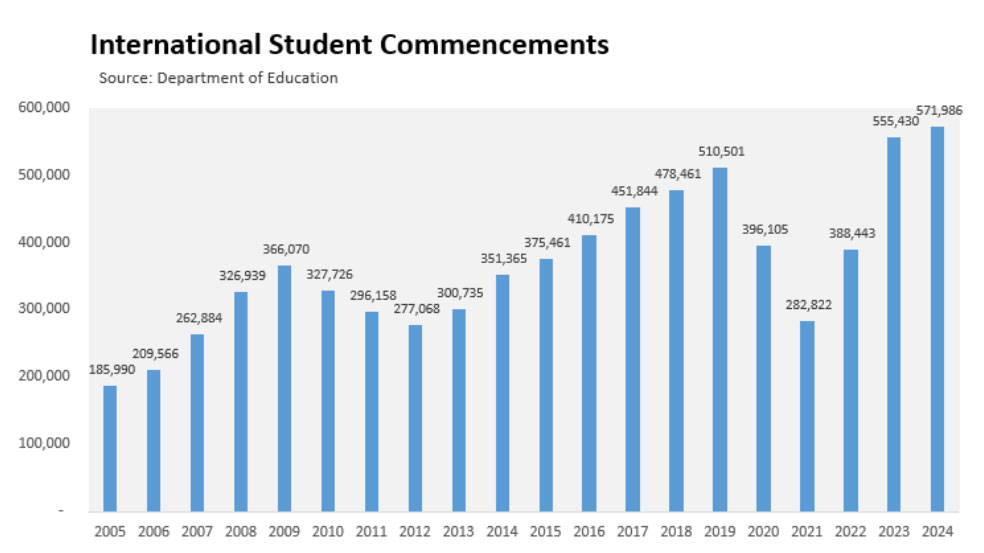
Recent data reports that other popular destinations for international students have seen a reduction in enrolments in recent years.
Demand for Canada, once the most desired destination, has plummeted since it implemented caps in 2024.
Numbers in the UK declined for the first time in a decade in 2023-24 after the government prohibited students from bringing partners.
The US Department of State recently ordered the processing of all new applications for international student visas to be put on hold.
Secretary of State Marco Rubio followed this up by indicating that the visas of Chinese nationals who are currently studying in the US will be “aggressively revoked”; this includes students with links to the Communist Party and those who are studying in critical fields.
Universities Australia says the nation’s higher education institutions are willing to enrol “academic refugees’’ who are barred by the Trump administration.
“Australia’s universities are open to the world”, Universities Australia chief executive Luke Sheehy said last week.
“If any students are displaced by policy decisions overseas, Australian universities stand ready to support those affected”.
Education Minister Jason Clare added that “we welcome genuine international students who want to study here’’.
“We have some of the best universities in the world”, Clare said last week.
“International education is a valuable national asset to Australia. It doesn’t just make us money, it makes us friends”.
Recent data found that Australia was the only major destination to register an increase in overseas student demand over the first quarter of 2025.
The report is based on survey responses from 240 institutions in 48 countries, mostly the key education destinations of the US, UK, Canada, and Australia.
The study found that Australia’s share of international student demand has climbed by 8% so far in 2025.
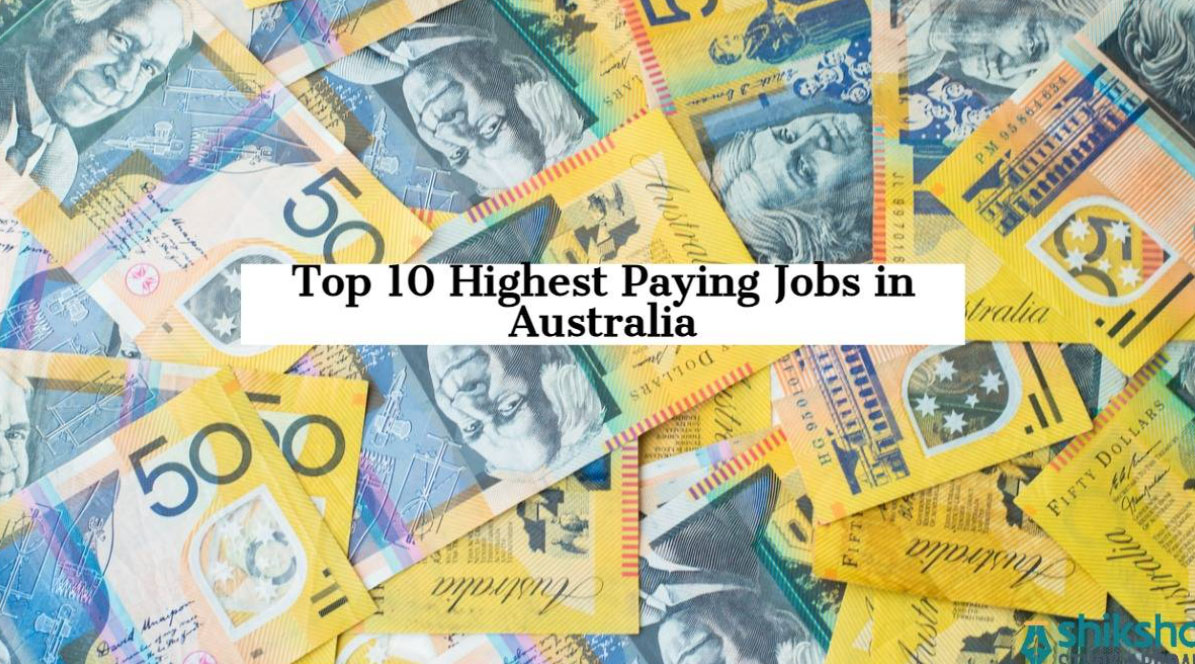
Regarded as one of the world’s popular study-abroad destinations, Australia attracts over a million international students each year for higher education. Out of these one million around 60% of them go for a research-level degree and around 30% vouch for working in Australia. Some of the world’s highest-paid jobs are offered in Australia. Check out about the top 10 highest paying jobs in Australia for international students.
The medical field in Australia is at its peak and has over 250,000 vacancies open in 2025. Similarly, the construction field also has a great scope in Australia, and many more industries.
List of Top 10 Highest Paying Jobs in Australia 2025
Though there are various job roles in Australia, sorted based on their value and demand, a few have topped the charts for 2025 and will continue to do so in the upcoming four to five years. Check out the recent list of highest paying jobs in Australia based on Australia’s current economic situation along with their average annual pay:
At present, Australia has a major opening for medical professionals and civil engineering professionals. Thus, the number of vacancies has gone up because of the demand. Hence, these professionals are highly paid for now in Australia.
Why Work in Australia?
There’s a reason why students wish to stay in Australia after their education: to find a full-time job in a land of opportunities and experiences. The reason why Australia attracts employees from all across the globe is because of the following reasons:
Top Paying Industries in Australia
In Australia, after the pandemic, various industries have geared up to welcome new professionals to bridge the employment gap. Some of these top-paying industries in Australia which also offer highest paying jobs in Australia include:
More and more industries like ICT, Accounting, Business, HR solutions, Fintech, Agritech and other related industries may also play a pivotal role in 2025 in broadening the job offers in Australia for professionals falling into these categories.
Top 20 Highest Salaried Job Roles in Australia
Check out the table below for the top 20 highest-paid jobs in Australia, along with career growth prospects:
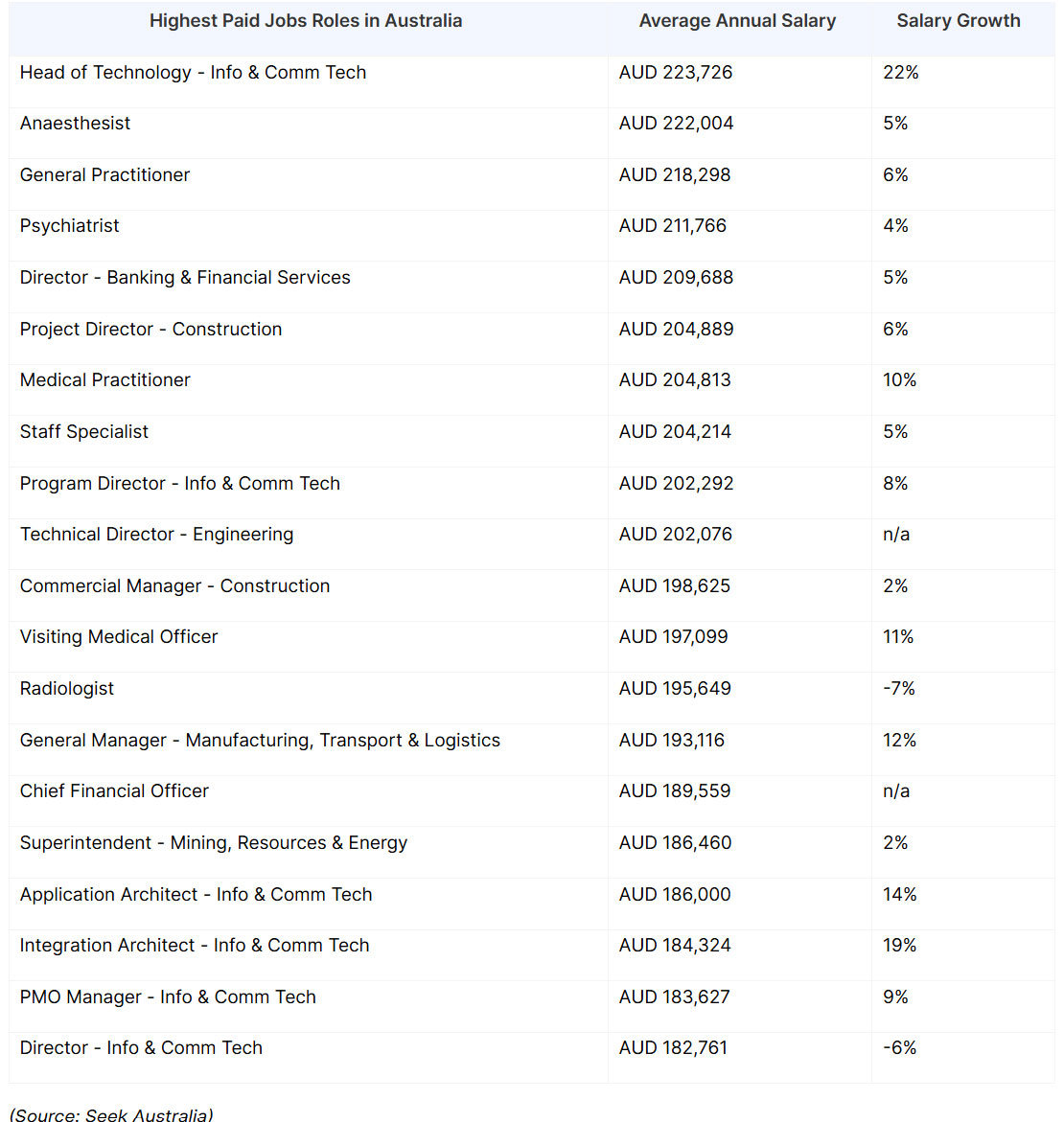
Thus, ICT and engineering-related job roles in Australia are not only highly paid jobs but also have scope for growth in the salaries of these professionals over the years. This growth is predicted based on real-time analysis, over the years since 2018.
How to find high-paying jobs in Australia?
There are various media outlets through which one can search for high-paying jobs in Australia. International students will have access to their university-specific career portals where jobs are posted and there are other ways too. Check them out below:
Thus, it can be concluded that Australia is a land of opportunities and good opportunities. International students can go for various full-time opportunities and, based on their academic performance plus previous work experience, be able to find high-paying jobs in Australia.

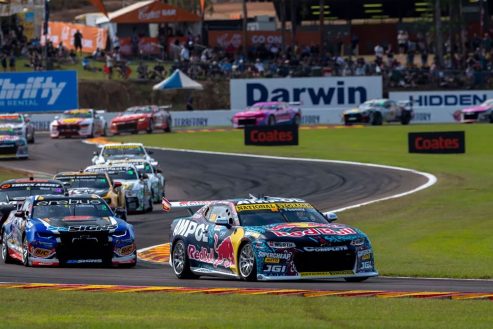







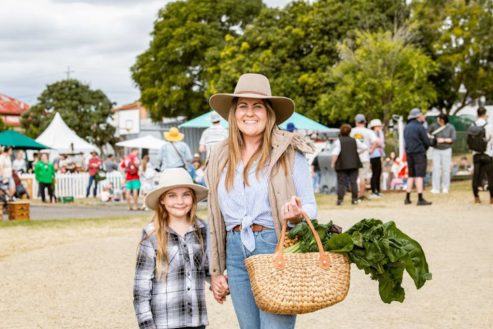
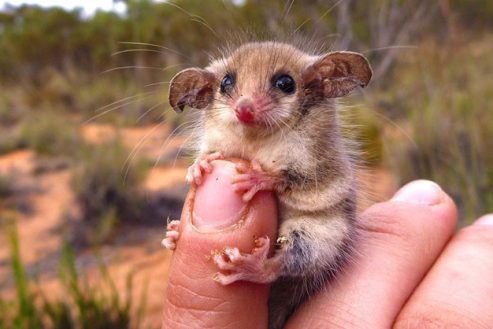

This Bulletin and its contents is for general information purposes only and should not be used as a substitute for consultation with professional advisors.
As legislation and travel requirements are constantly changing, we strongly recommend obtaining advice on your individual situation from a Registered Migration Agent. Please click here to book a consultation with one of our Registered Australian Migration Agents, located in Australia.






You can manage your membership and billing method by clicking here
Terms of Service
Privacy Policy
Copyright © 2025 Office of Immigration Australia, a private company registered in Australia. All Rights Reserved.